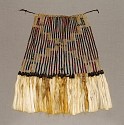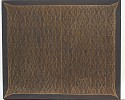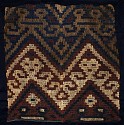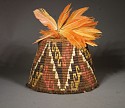
Peru, 3 Inca Slings
These three slings double as tethers and were used to restrain llamas by attaching them through a hole in the ear. Llamas were herded by the Incas and were the primary source of cargo transport in the Andes. A llama could carry up to ninety pounds of cargo on its back.
Media: Textile
Dimensions: mounted dimensions: H. 36 x L. 17 in.
$3,000
89505A
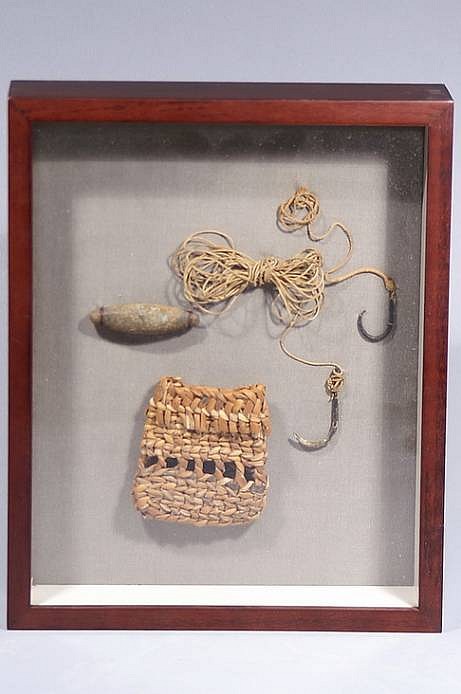



Chile, Arica Chilean Fishing Kit consiting of hook, line and sinker
This kit consists of a small finely woven basket for carrying the assembled items of fishing line with hook and sinker. The line cord is spun and plied of cotton. It is unusually well made, hard-spun, with a two-strand cord. There are two straight shank fish hooks, the smaller made of copper and the larger of cactus thorn - both without barbs. The sinker is cigar shaped stone. A fine cord lashing was used to attach the sinker to the loop of heavy cord. With this system, the weight could be easily attached to or removed from the line. Similar excavated fishing material is illustrated in "Excavations in Northern Chile," Anthropological Papers of the American Museum of Natural History (1943), and also in Junius Bird, "The Cultural Sequence of the North Chilean Coast," Part 3, Southern Andes, in "Handbook of South American Indians" (1946: II: 587-597).
Media: Textile
Dimensions: Length 6 1/2, width 4 1/2 and Height 4 1/2 inches
Price Upon Request
M8049
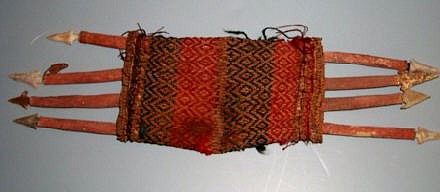
Chile, Arica harpoon quiver with harpoon points
A fiber quiver decorated in red and green reed, with its original wood harpoon points and napped points. The wood harpoon points are set into a longer throwing stick and the point releases when the harpoon is retrieved. The quiver also known as a Porta Harpoon (harpoon carrier) and holds eight points. It was used by the fisherman to hold his ammunition for an extended trip. Junius bird describes and illustrates these porta harpoons in "EXCAVATIONS IN NORTHERN CHILE", 1943 pg. 223.
Media: Textile
Dimensions: Length 23" from point to point x Width 7"
Price Upon Request
MM201
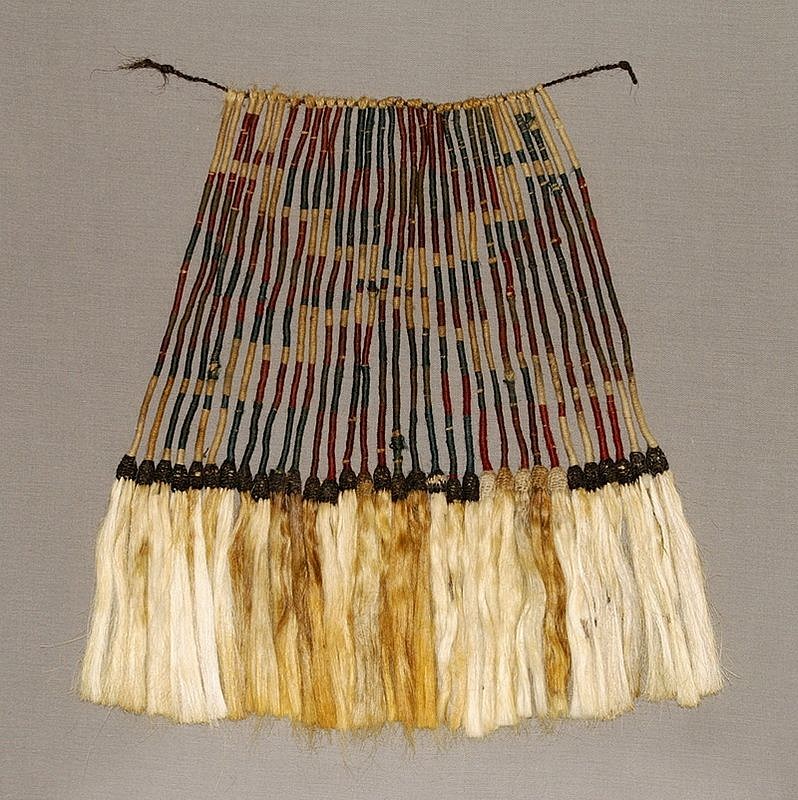




Chile, Arica Small Loincloth
The lion cloth is comprised of 32 individually wrapped strands of vicuna. The design of the Andean cross appears when the strands are aligned. A similar small mens loincloth is illustrated in Arica Diez Mil Anos, Museo Chileno (1985: 57).
Media: Textile
Dimensions: Height: 12" x Width: 14"
$6,500
M8063
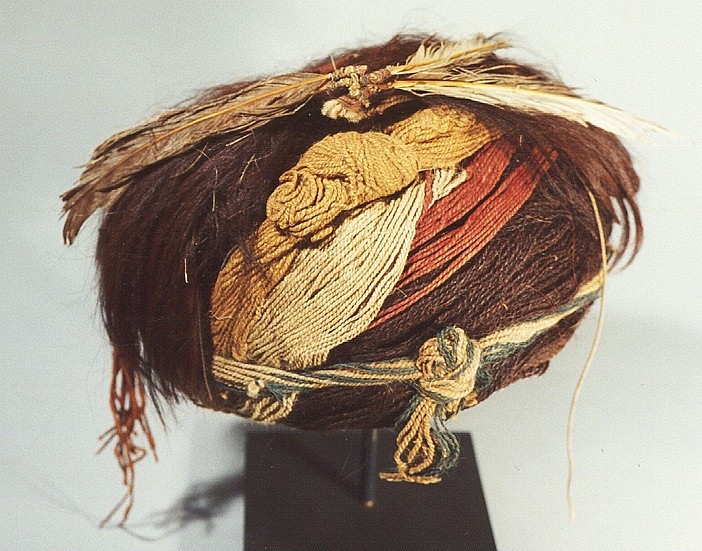
Chile, Cameronie turban with henna colored hair with upright fiber tassel
Cameronie is a coastal fishing center inhabited as early as 900 B.C. and occupied until 1100 A.D.. The turbans were made prior to the acceptance of weaving. Much importance was placed on head-gear in Chile.
Media: Textile
Dimensions: Approx. Diameter 8 in.
$4,250
91283B
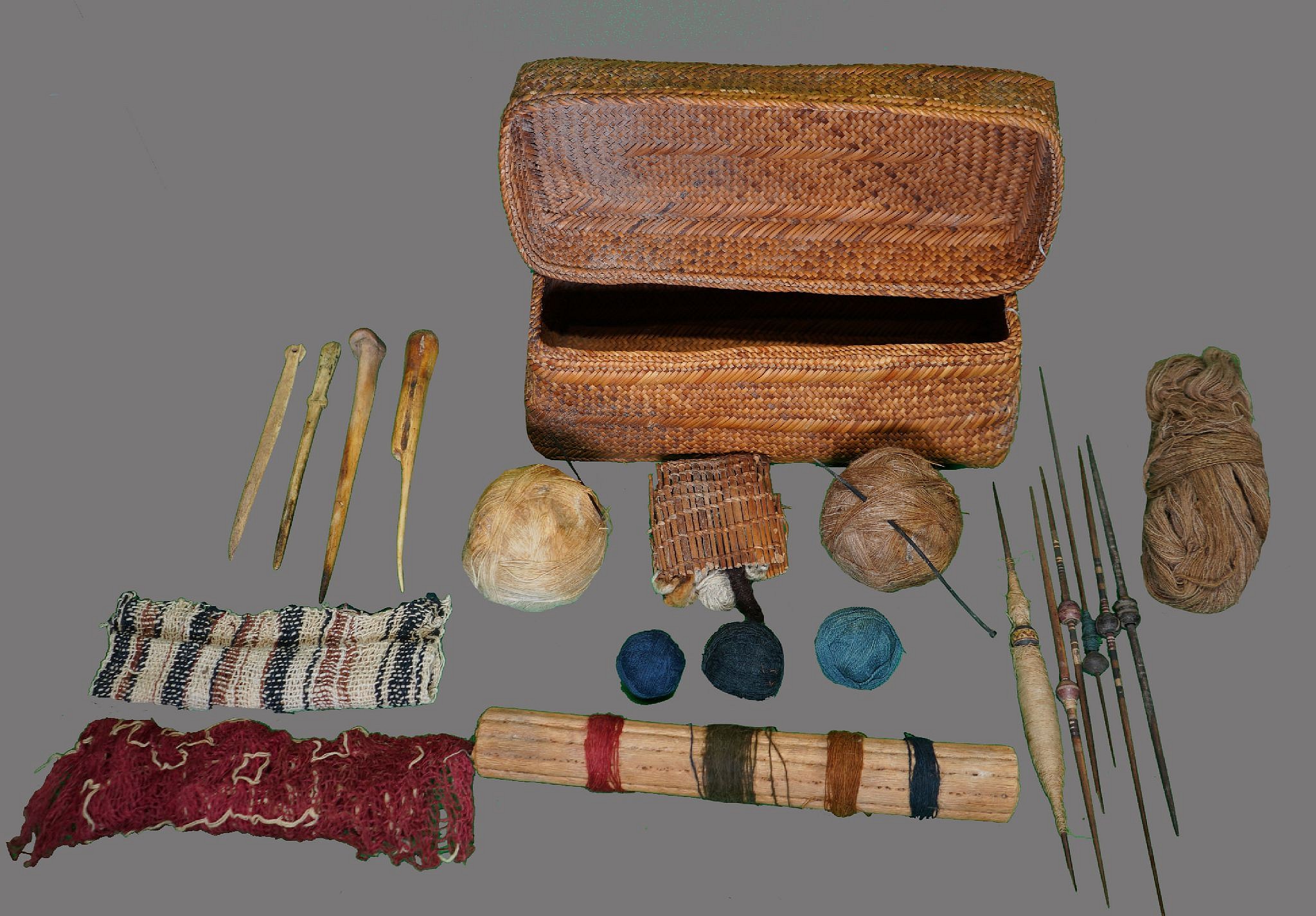
Chile, Chancay Basket with Weaving Implements
This rectangular reed basket with separate cover contains a complete ancient Peruvian weaving kit. The basket has bamboo ribs to support its shape. Based on the contents, it appears to have been used for weaving garments for Chancay dolls. The contents include: two large and three small wound balls of thread in a variety of colors, five spindle whorls, one bobbin, two thorn needles, two bone needles, a shed rod, and three small ancient woven panels. All the components are ancient and were found together in the basket.
Media: Textile
Dimensions: H. 4 3/4 x L. 11 1/2 in.
Price Upon Request
91272



Peru, Chancay Fringed Tapestry Border with Cats and Birds
This was likely the border of a tunic and was made as two loom widths sewn together with an additional fringe sewn horizontally. The design of cats and birds alternating in angled bands is bordered above and below with rows of additional small birds. It is unusual to see such red and gold highlights dyed on cotton.
Media: Textile
Dimensions: Width: 37" Height: 9"
$2,200
94277
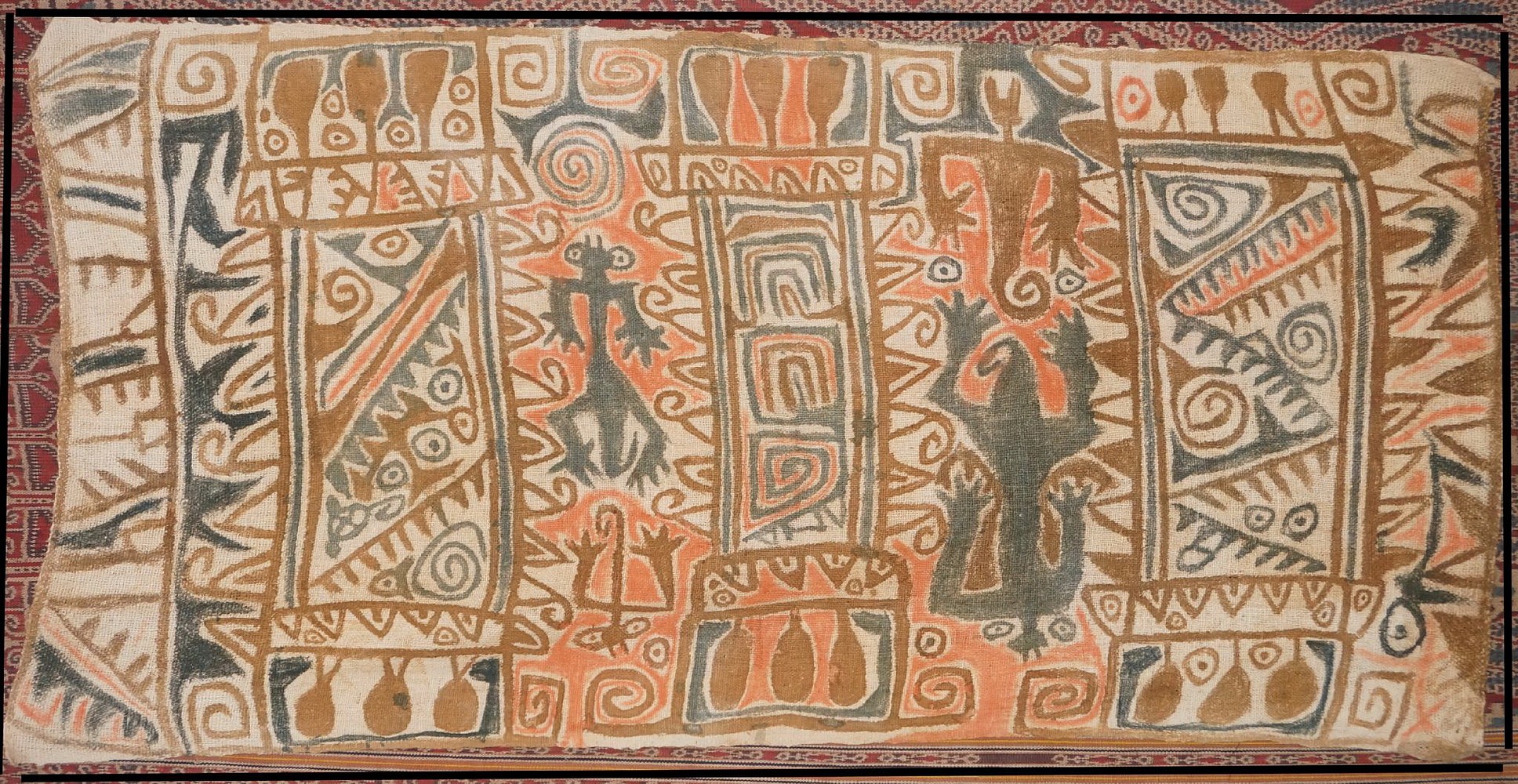


Peru, Chancay Painted Cotton Panel with Four Abstract Figures and Symbols
The cotton panel is painted in blue, tan and orange. The drawing can be interpreted as 3 woven panels or tunics with fringes, each decorated with different abstract designs. On each side of the central panel are two abstract creatures with curly tails on an orange ground.
Media: Textile
Dimensions: Length: 46" x Width: 23"
$7,500
n6056h
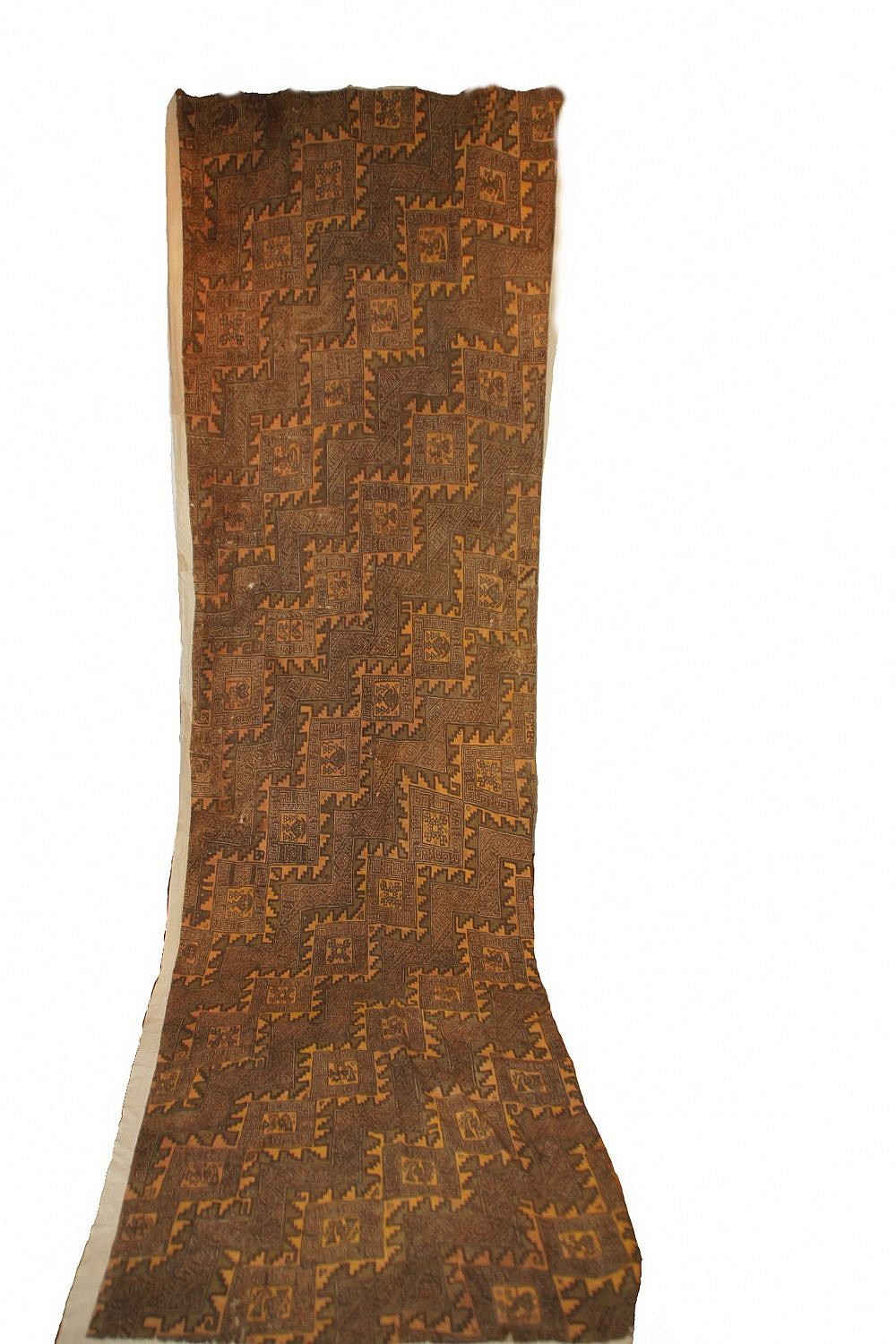




Peru, Chancay stamped decorated woven panel
The decoration is a combination of resist dying and then stamped design. There are over 7 different motifs all arranged in diagonal patterns.
Media: Textile
Dimensions: Length: 15'(180") x Width: 4'(48")
$15,000
N2027
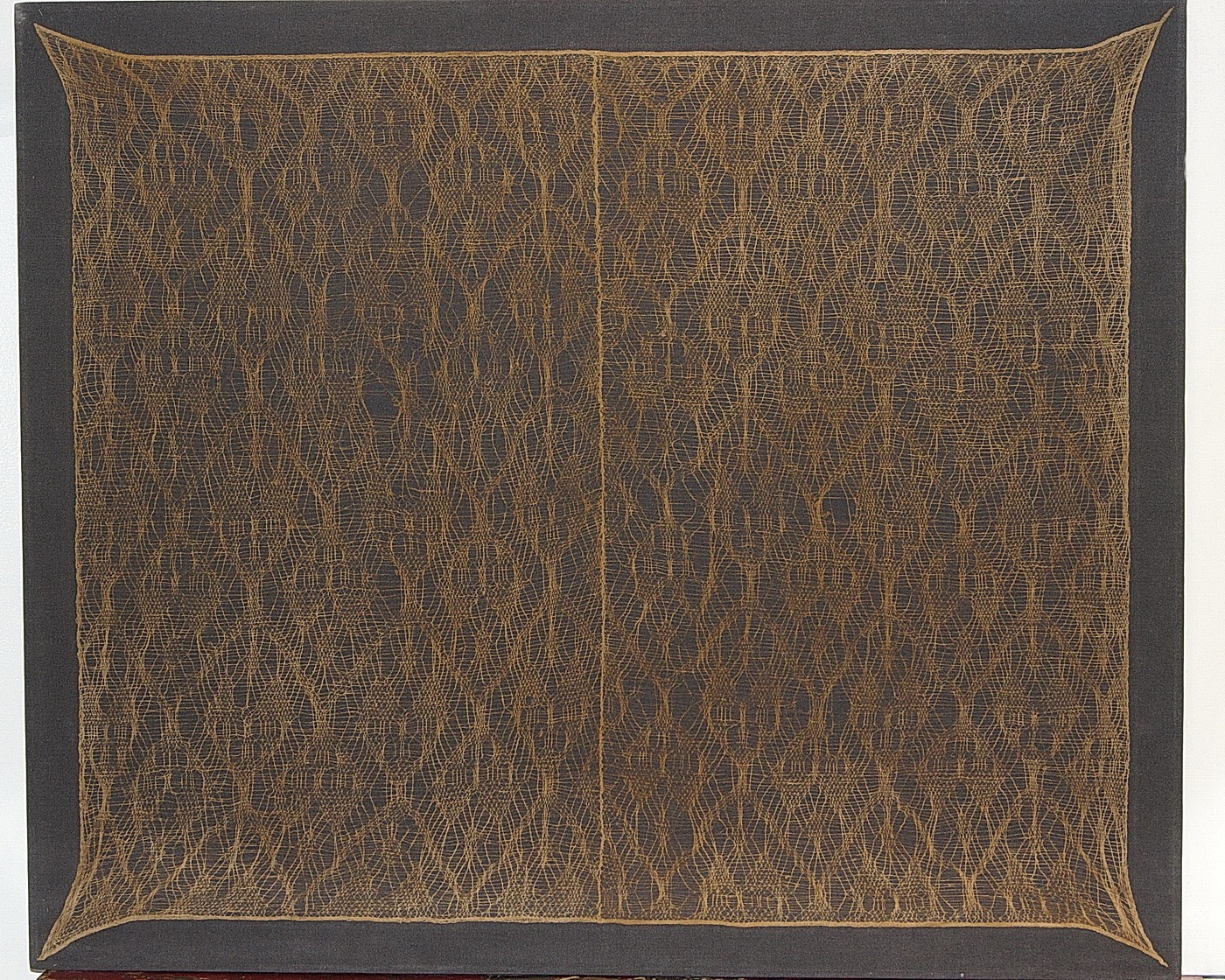
Peru, Chancay Tan Gauze Witch's Vail with a Complex Pattern of Cat Faces
Tan cotton complex gauze decorated with a lace-like pattern of cat faces in alternating orientations. Witches’ vails are often seen on Chancay dolls. This example has tightly spaced cat faces, making the gauze very dense and complex.
Media: Textile
Dimensions: Height 38" x Width 32"
$3,350
94277A
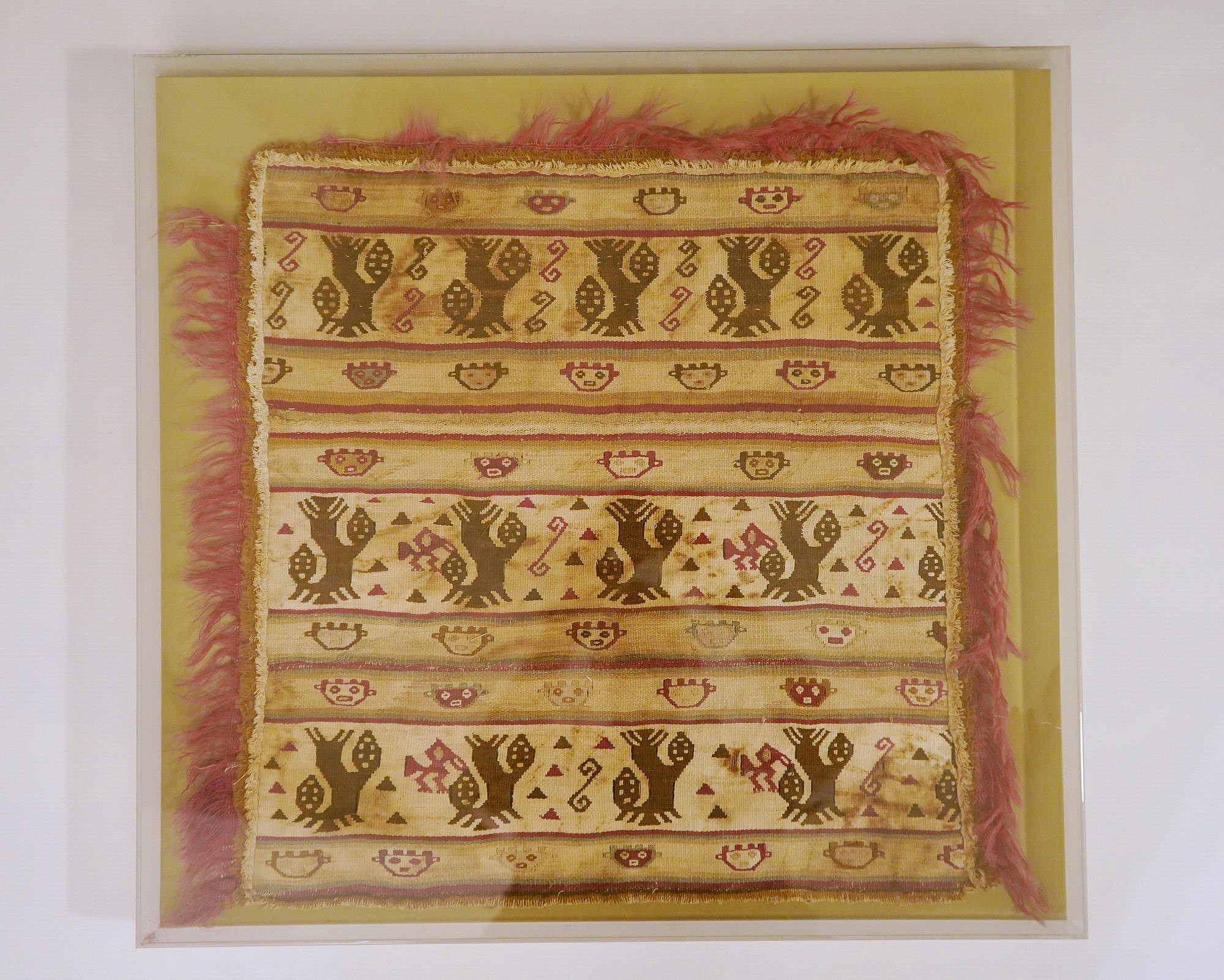


Peru, Chimu Tapestry Panel with 18 Cacti
The panel is arranged with three rows of cacti, probably the San Pedro cactus species. The San Pedro is also eaten as psychoactive fruit and is shaped like a star or flower when sliced. This panel illustrates three rows of plants, each with a bird eating the fruit. The rows of cacti are bordered by double rows of stylized crowned Chimu crowned.
This panel was cut from a larger weaving. The fringe is authentic, coming from the original weaving, but was re-attached. The panel is mounted in a Plexiglas box. The framer used an adhesive to attach the weaving to the ivory cotton ground; it should not be removed from the stretcher.
Formerly in a New York private collection prior to 1979.
Media: Textile
Dimensions: Height: 22" x Width: 23"
$3,250
n9042
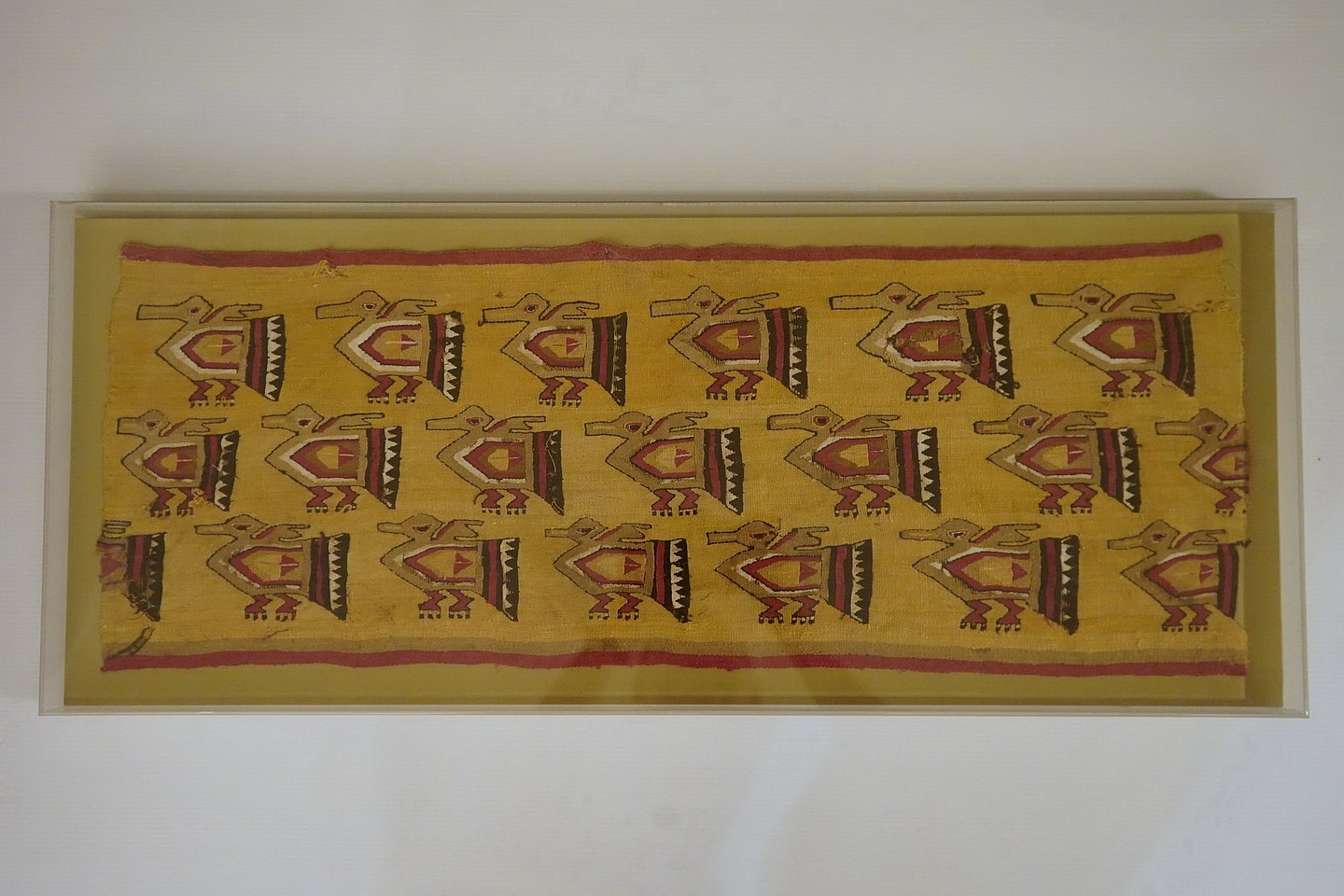


Peru, Chimu Tapestry Panel with 18 Ducks in Profile
This tapestry features 18 ducks in profile, and arranged in three rows, each oriented in the same direction. Each duck has one wing stylized in the shape of a single feather and the other behind its head. There is delicate detailing in the feet and tail feathers. The panel is mounted in a Plexiglas box. The framer used an adhesive to attach the weaving to the ivory cotton ground; it should not be removed from the stretcher.
Media: Textile
Dimensions: Height: 13" x Width 31"
Price Upon Request
n9041
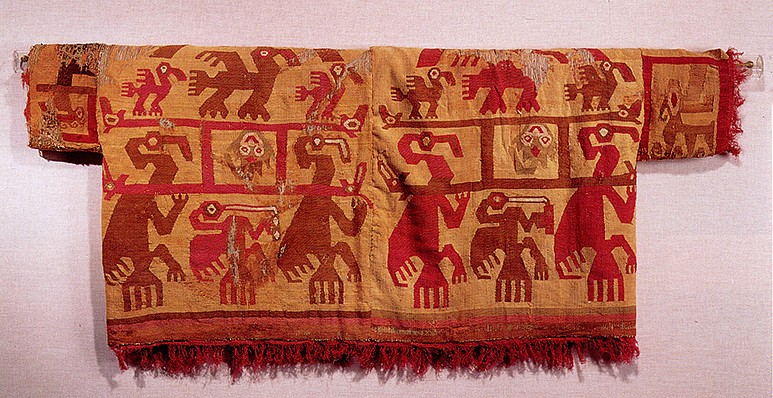




Peru, Chimu Tapestry Shirt with Pelican Narrative
This is a complete tapestry woven shirt with sleeves constructed of cotton warps and camelid wefts in red, brown, olive and white on an ochre ground. It depicts a mythical marine narrative with two pelicans carrying a litter bearing a trophy head in the form of a skate with a face. Litters were considered a prestigious mode of transportation on the North coast. The presence of this image within the narrative reinforces the importance of the individual who wore this shirt. There is a pelican with a crescent headdress on top of each litter. Each of the four panels displays the same scene in reverse colors. This shirt is illustrated in Rowe, Ann, "Costumes and Featherwork of the Lords of Chimor" published by The Textile Museum, 1984, fig 103. Formally in the collection of the Southwest Museum in California.
Media: Textile
Dimensions: Width 47-1/2" x Length 19-1/2"
Price Upon Request
96127
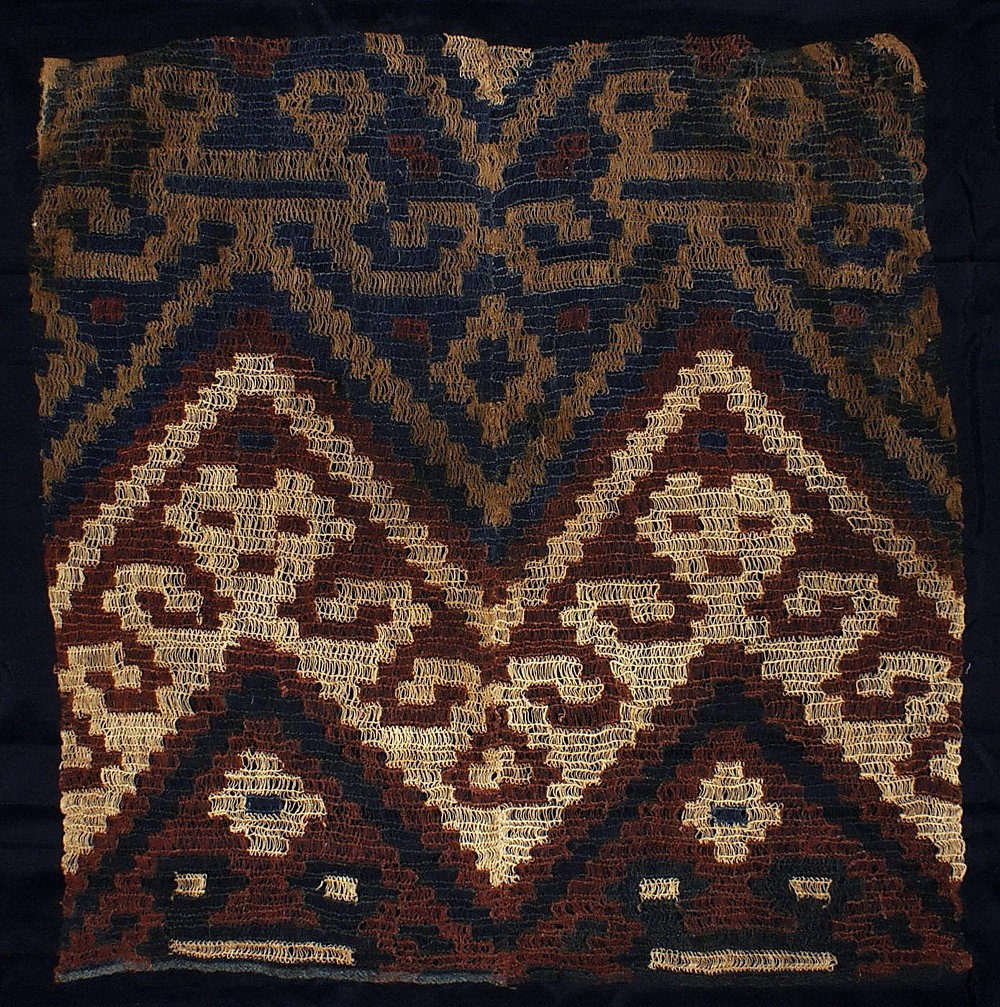





Peru, Colorful Chancay Gauze with Abstract Faces
This is a very unusual gauze in blue, red, and saffron colors. It is woven in two panels and depicts three bands of large abstract faces, bordered by step clefs. In the opposite orientation the faces appear as skates and frogs.
Media: Textile
Dimensions: Length: 27" x Width: 26"
$8,000
n6053h
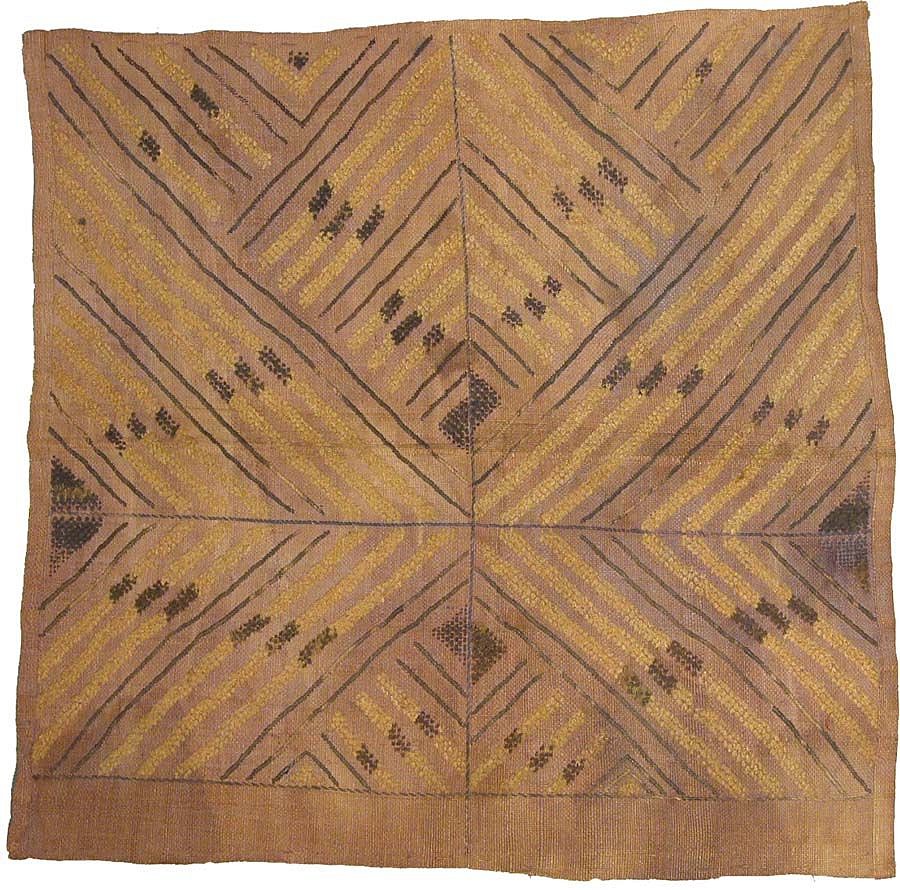


Zaire, Dekese (Kuba Kingdom) Raffia Panel with X-shaped Motif
Woven palm-leaf fiber panel embroidered with four variations on the same V-shaped motif which intersect to form a large “X.†The panel was embroidery cut to form a pile surface, resembling velvet. This panel was brought back by one of the members of H.M. Stanley's famous expedition to Central Africa in the late 1800's.
Media: Textile
Dimensions: Length 23.5" x Width 23.5"
$450
M4089













Peru, Early Nazca/Late Wari Tie- Dye Patchwork Rectangular Bag
This tie dye rectangular bag with discontinuous interlocking patchwork was probably used for carrying feathers. The bag was made from surplus squares left over from a larger mantle, utilizing the scaffold technique. Collected by Gunnolf Bjorkman who worked in Lima in the 1960's and settled in Buenos Aires.
Media: Textile
Dimensions: Length: 26" x Width: 4 1/2 in.
$7,250
91265
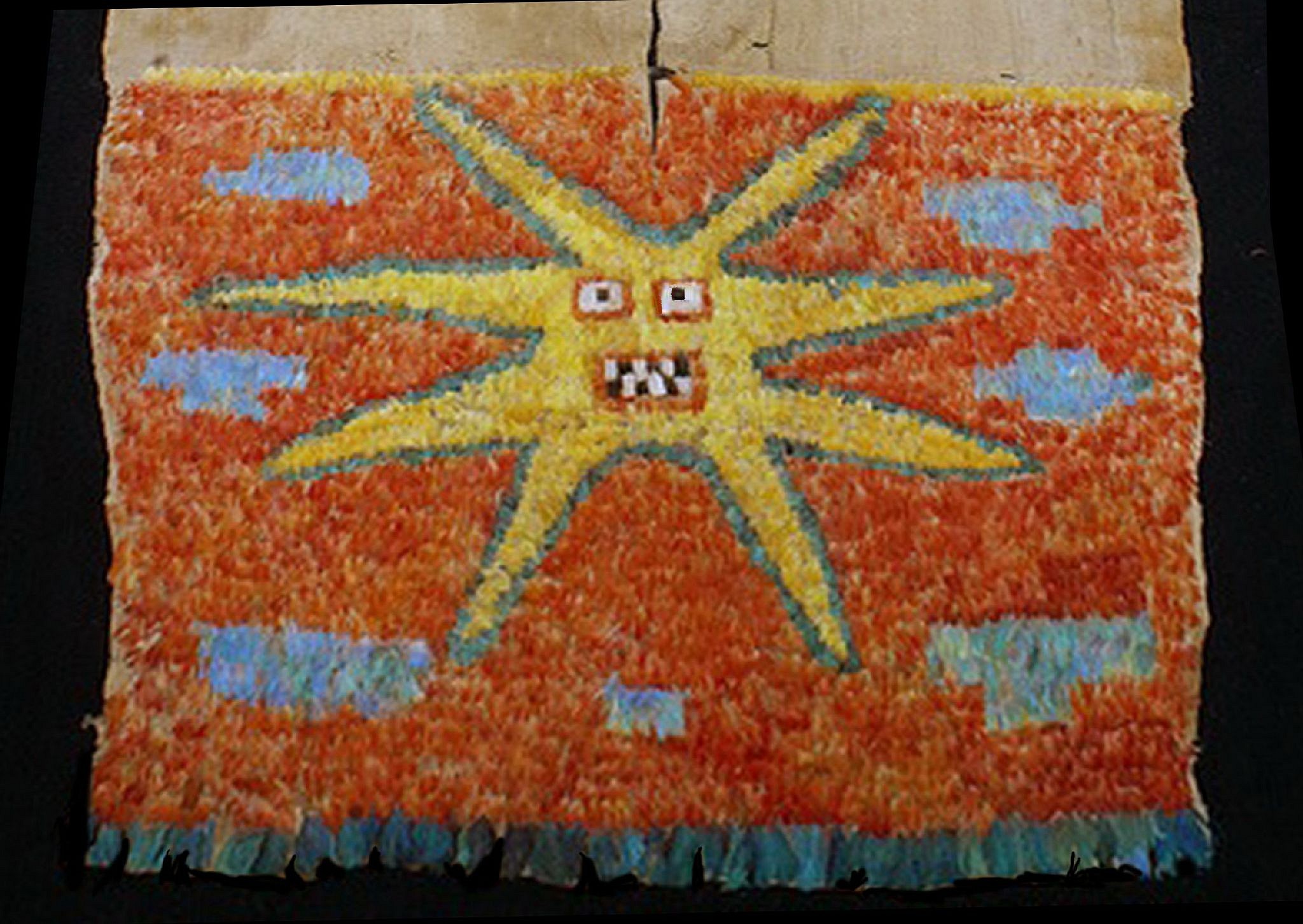






Peru, Early Nazca/Sihuas Feather Tunic With the Eight Pointed Star On an Orange Ground
This tunic with an eight-pointed star motif, also referred to as the Radiant Sun, is similar to other published tunics. The front part is a complete star with assorted color blocks of blue feathers. The back of the tunic has only two blue stripes on an orange ground with a fringe of turquoise macaw tail feathers. The blue feathers do not contain blue pigment, but instead are natural prisms which brightly reflect the color of the sky. I believe that all the feathers are from the Scarlet, Yellow, and Blue Macaws. Tunics with similar motifs are illustrated in TEXTILE ART OF PERU, 1989, L.L. Editores, Lima. pages145,-147 & 163. Usually tunics with an eight-pointed star motif are from the Nazca region, from the South coast of Peru. This tunic was found in the Sihuas region near the city of Arequipa and predates the Nazca by 500 years. The backing fabric is fragile and needs proper conservation.
Media: Textile
Dimensions: Length 56" x Width 35" (142cm X 88.9cm)
Price Upon Request
N1028





Peru, Huarmay Tapestry Border to a Poncho with Three Warriors
This classic Huarmay style tapestry is crafted in the classic Huarmay colors of ivory, blue, and red with black outlines. Each warrior wears different colors, and each holds a tumi in his left hand and wears an elaborate headdress with two long, forward-tilting plumes. Separating the warriors are blocks of ivory with three abstract birds on a diagonal. Along the bottom edge is a repeating classic step volute line in blue with a white outline. The Huarmay culture thrived during the Late Moche Period on the most Southern of the fourteen Moche valleys, and were influenced by the Wari. Mounted, in a Plexiglas box. Minor losses to the ivory central panel. Formerly in a New York private collection prior to 1979.
Media: Textile
Dimensions: Width: 48" x Height: 6 1/2"
$8,500
n9040
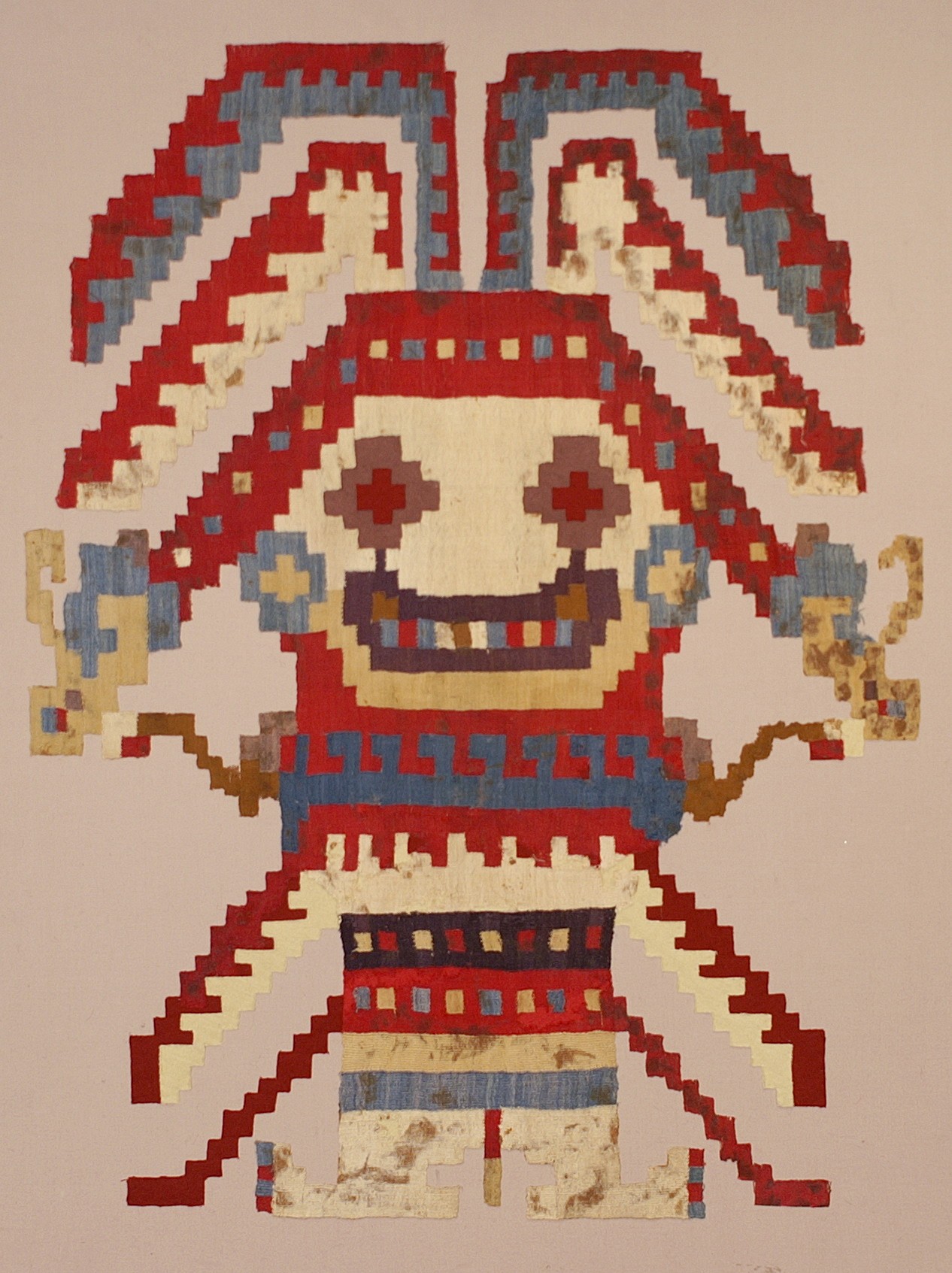



Peru, Huarmey Tapestry deity with rayed headdress
This is a very large single figure for any Peruvian weaving, and it was originally attached to a mantle of sheer cotton. The figure wears a headdress, ear spools, necklace, and tunic with a serpent belt in the red, blue and ivory colors typical of Huarmey textiles. The Huarmey Valley is the most southern in the Moche area and had, therefore, a lot of Wari influence in its art. This figure is stylistically more Wari than Moche in its abstract appearance.
Media: Textile
Dimensions: Length 32" x Width 24"
Price Upon Request
92305
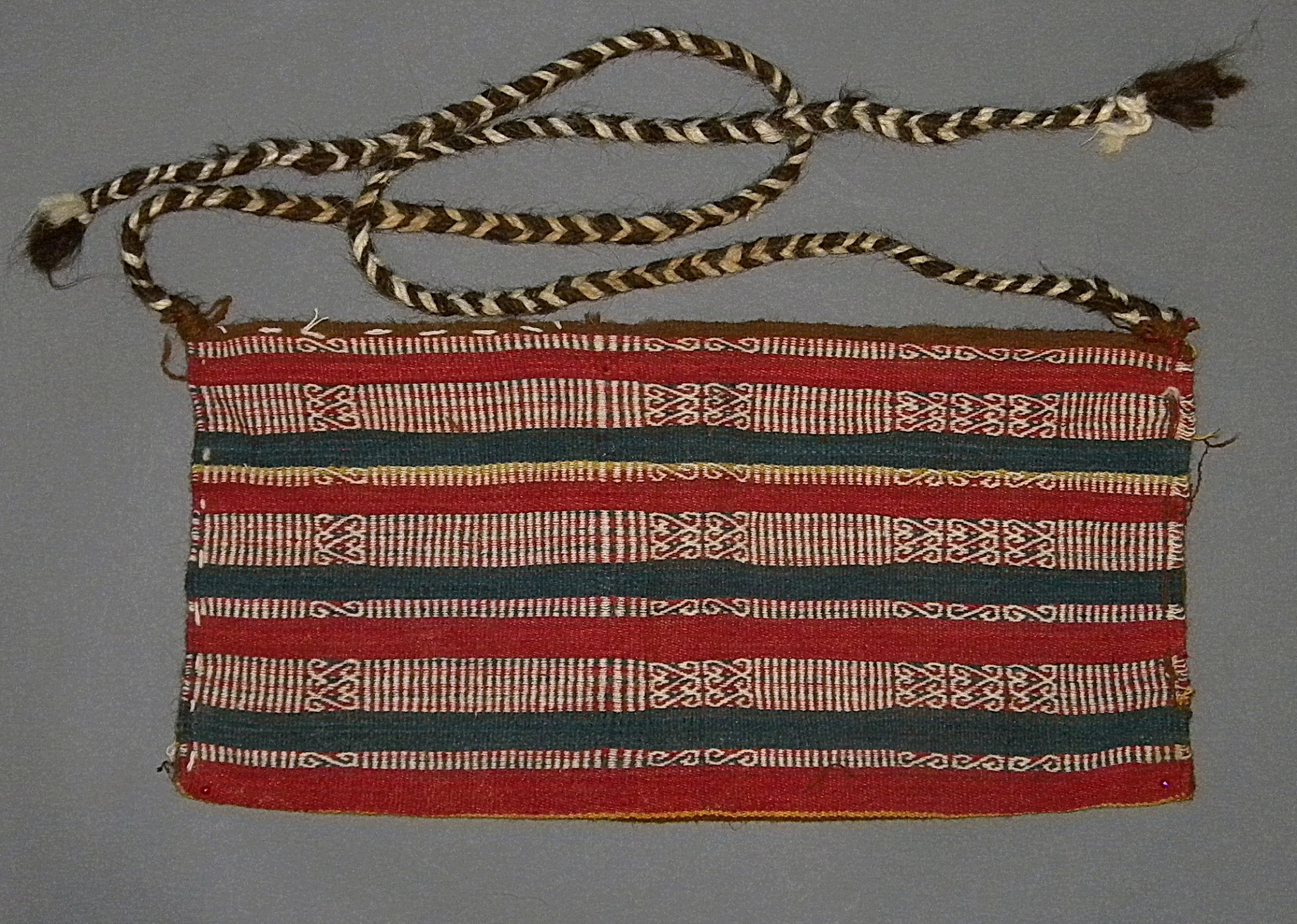


Chile, Inca Faja Bolsa (Bag Belt)
This Faja Bolsa has extremely good colors and presevation, in blue, red and white. geometric striped design. The belt was worn around the waist and over a tunic. As tunics have not pockets, the bag belt allowed the wearer to store items from coca leaves to corn, something like a Money Belt is used for today. A similar example is found in "Arica, Diez mil Anos", Museo Chileno de Arte Precolombino, page 80, no. 180 & 181. Woven of alpaca wools. Weavings from Pica, Chile are usually in excellent condition with bright colors.
Media: Textile
Dimensions: Width: 6 x Length:. 17 � in.
$2,750
90247
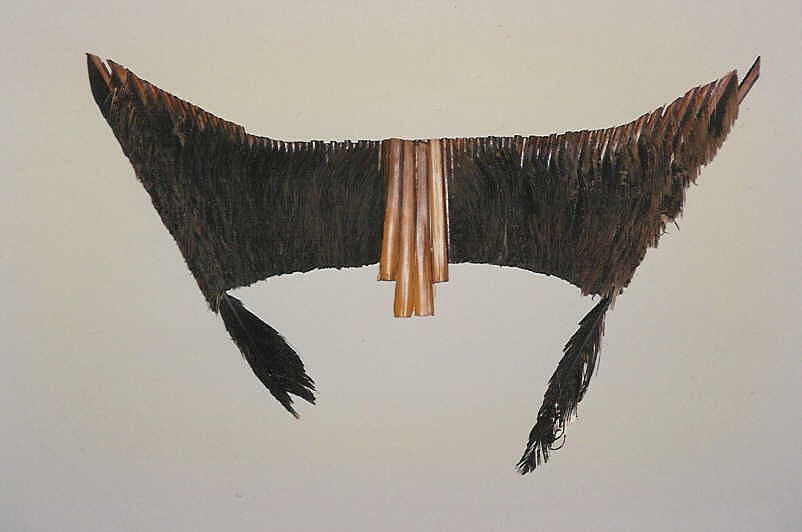


Chile, Inca feather shaman's mask with feather Nose appendages
This mask was worn by shaman to create an owl like impression. It is constructed by threading the individual duck feather quills. Figurative pottery images have been seen wearing this type of face mask. Similar masks are illustrated in ARICA 10,000 YEARS. Another example is illustrated in "Identity and Prestige in the Andes" pg 52.
Media: Textile
Dimensions: H 6 1/2" x W. 7"
$1,800
88033B
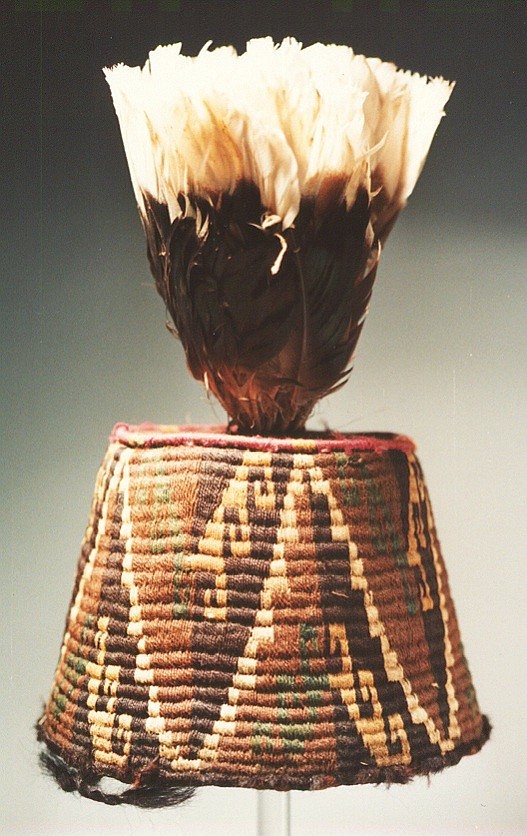
Chile, Inca Fez hat with step/scroll design in varying brown and green.
The hat has an undulating pattern of varying shades of brown. The green decoration is minimal and very subtle.
Media: Textile
Dimensions: diameter 4 1/2 in.
Price Upon Request
92229
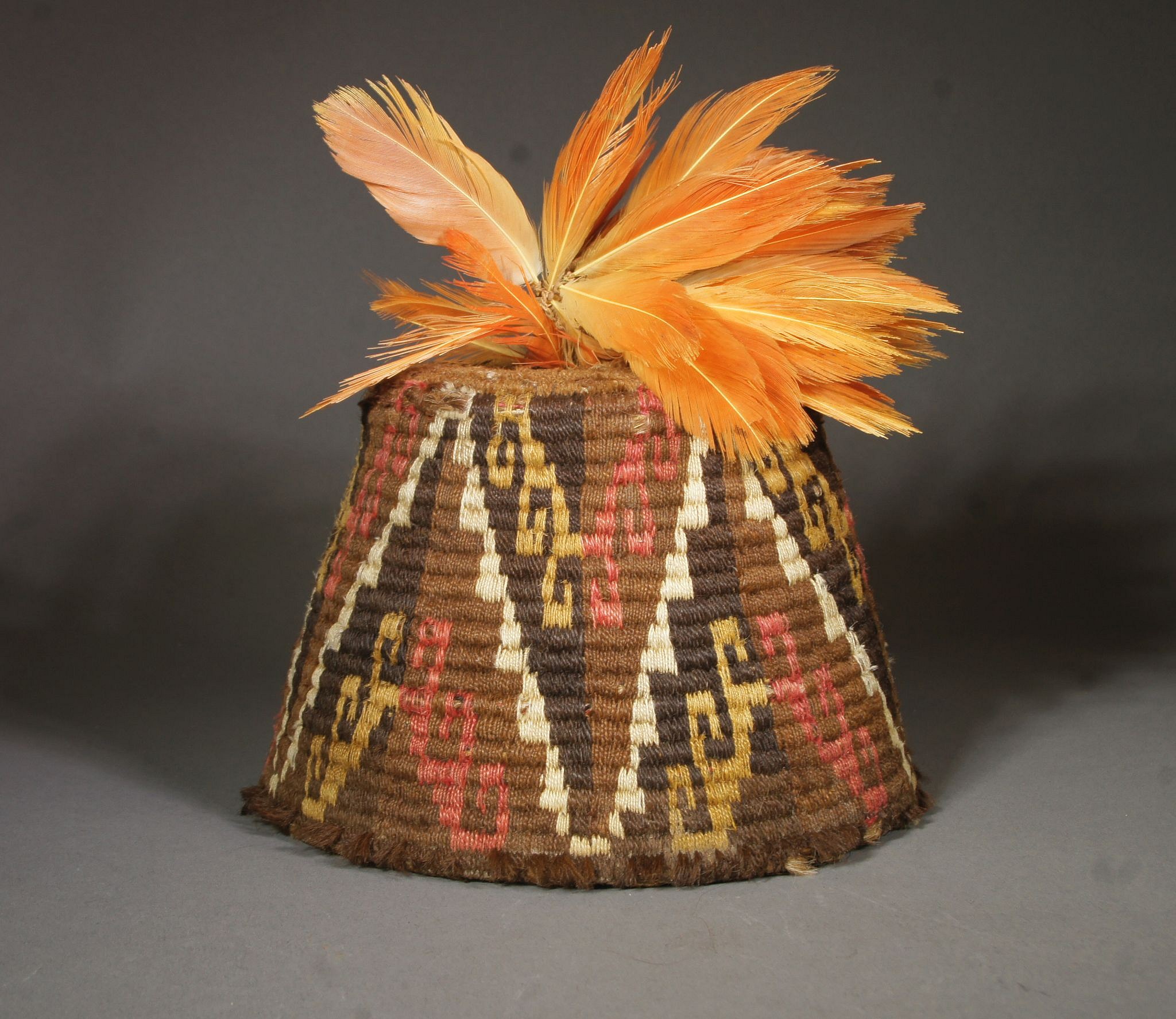



Chile, Inca fez style hat with step design in brown, gold, white and pink and feather plume
A fez style hat was placed as the final adornament on the Inca mummy bundles of Pica, Chile. They were not made anywhere else in all of the Inca Empire. They were made by a coil method wrapping different colored wool yarns around the coils to acheive the quartered step pattern. A similar example is illustrated in Arica Diez Mil Anos
Media: Textile
Dimensions: H. 4 1/4 in.hat only H. with feathers 9"
Price Upon Request
91362
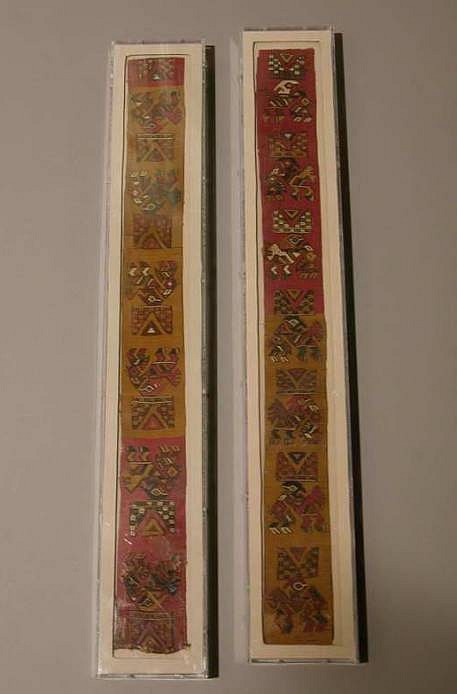




Peru, Inca/Ica Tapestry Borders to a Tunic depicting creatures in profile holding a bird
A very finely woven tapestry work in alternating color arrangements on tan and red grounds. The creature is wearing an upside down tunic on his head with a early Inca motif of checkerboard pattern. Color is used to create hidden images.
Media: Textile
Dimensions: Length 24 1/2" x Width 3 1/4" framed / 23" x 2 1/4" unmounted
$4,850
M3136
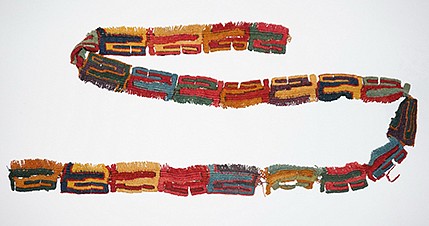





Peru, Knotted Textile Fringe with Colorful Abstract Motif
This knotted fringe is distinguished by its brilliant colors and abstract "z" motif repeated along the band. It was not woven on a loom but instead was created by a method referred to as "tubular looping." Looping is a single-element technique in which the free end and full length of the yarn are pulled through previous work at the edge of the fabric to form each new loop. Looping predates the domestication of fiber-bearing plants and animals and the invention of weaving in the Americas and possibly Eurasia. The choice of color combinations creates a vibrating impact.
Media: Textile
Dimensions: Length: 61 inches; Width: 2 inches
$3,000
91105




Peru, Large fragment to a Wari tunic in Unusual Colors with Abstract Monkey Faces
The fragment consists of two large sections that join, making it almost 60 inches in length. The design is of opposing monkeys in profile. Both profile monkey faces also combine to create a third, larger monkey face in two colors. The monkey’s tail turns into a step fret motif, typical of Wari tunics. The thread count is high, at around 120 per inch. The warps are of cotton and the wefts are of fine alpaca. Cotton warps suggests that the tunic was woven on the coast.
Media: Textile
Dimensions: Overall length is 60" x Width of 20"
Section A Length: 30" x Width: 20"
Section B Length: 30" x Width: 20'
$6,950
n7018













Peru, Late Paracas Needlework Border with Hummingbirds and Cactus Flowers
The border is composed of cross loop needle-knitted hummingbirds sucking the nectar from flowering cacti in alternating color arrangements. There are ten basic colors with additional tones to include blues, grays, greens, gold, pinks, purples, reds, tans and whites. Each bird's head has a long beak, different colored eyes, a slender body, and a wide tail. The cacti are made in five parts, from the upper flower to the lower flower’s broad cactus leaves. The Nasca people are considered to have the most colorful costumes in all antiquity. Their richly colored weavings are often perfectly preserved, having been buried in the driest dessert in the world. Nasca borders and fringes would surround an entire mantle or tunic, which could be many yards in length. The Metropolitan Museum of Art has only two short segments depicting hummingbirds. The Textile Museum in Washington, D.C. has a similar border that is only 21†in length, which is illustrated in EARLY NASCA NEEDLEWORK by Alan Sawyer, image 116. Other early Nasca needle knit birds are in the Met Museum. Formerly in the collection of Justin Kerr, New York, prior to 1970.
Media: Textile
Dimensions: Length 40" x Height 3"
Frame dimensions: Length 42" x Height: 9"
Price Upon Request
n7035
![Peru, Late Paracas/Early Nasca Embroidered Section with Four Colorful Monkey Deities in Alternating Colors on a Gold Ground
This textile portrays a series of ecstatic shamans as Animal Impersonators. The main figures, depicted with flying wings, are referred to as monkey deities because they have opposing toes. The bright, abstract color combinations not normally found in nature and the dense shamanic imagery such as double-headed serpents, flint knives, and trophy heads, could easily have been the result of a psychedelic journey. Note: Psychiatrist Oscar Janiger’s studies in the 1950s revealed that that LSD “not only radically changed the [artist’s] style but also gave them new depths to understand the use of color, form, light, or the way these things are viewed in a frame of reference.†(Dobkin/Janiger, 2003, p.80]. The beautifully contrasting colors, and the fluidity of the figure-ground relationship of this Paracas textile connotes a psychedelic influence on the ancient Paracas and Nasca people -possibly that of psilocybin. Shamanic animal transformation in Andean art represents the journey to the afterlife by way of psychic flight.
From top to bottom: The top figure wears a grey puma headdress with Chile peppers, a white nose ornament, and a tunic with a step volute border. Serpents with suspended kidney beans flank him on both sides, and another serpent emanates from his mouth. The second wears a diadem on his forehead, a cloak, and a loin cloth, and is surrounded by three animal heads. He wears a gold mask with a serpent emanating from his mouth and holds a trophy head in one hand and a flint knife in the other. The following figure repeats the compositional structure of the first figure but has a completely different color arrangement. The last figure repeats the structure of the second figure, also in completely different colors. No two figures are the same, and the curvature of the snakes created in alternating colors conveys a sense of motion. Another section from the same textile is in the Israel Museum, Jerusalem. Period: Peru, Paracas-Ocucaje 10, or Nasca 1, South Coast, c. BC 100 - AD 100
Media: Textile
Dimensions: Textile, Length: 24" x Width: 2 3/4" Plexiglas frame, Length: 27"x Width: 5 1/2"
Price Upon Request
pp008](/images/16081_h2048w2048gt.5.jpg)
![Peru, Late Paracas/Early Nasca Embroidered Section with Four Colorful Monkey Deities in Alternating Colors on a Gold Ground
This textile portrays a series of ecstatic shamans as Animal Impersonators. The main figures, depicted with flying wings, are referred to as monkey deities because they have opposing toes. The bright, abstract color combinations not normally found in nature and the dense shamanic imagery such as double-headed serpents, flint knives, and trophy heads, could easily have been the result of a psychedelic journey. Note: Psychiatrist Oscar Janiger’s studies in the 1950s revealed that that LSD “not only radically changed the [artist’s] style but also gave them new depths to understand the use of color, form, light, or the way these things are viewed in a frame of reference.†(Dobkin/Janiger, 2003, p.80]. The beautifully contrasting colors, and the fluidity of the figure-ground relationship of this Paracas textile connotes a psychedelic influence on the ancient Paracas and Nasca people -possibly that of psilocybin. Shamanic animal transformation in Andean art represents the journey to the afterlife by way of psychic flight.
From top to bottom: The top figure wears a grey puma headdress with Chile peppers, a white nose ornament, and a tunic with a step volute border. Serpents with suspended kidney beans flank him on both sides, and another serpent emanates from his mouth. The second wears a diadem on his forehead, a cloak, and a loin cloth, and is surrounded by three animal heads. He wears a gold mask with a serpent emanating from his mouth and holds a trophy head in one hand and a flint knife in the other. The following figure repeats the compositional structure of the first figure but has a completely different color arrangement. The last figure repeats the structure of the second figure, also in completely different colors. No two figures are the same, and the curvature of the snakes created in alternating colors conveys a sense of motion. Another section from the same textile is in the Israel Museum, Jerusalem. Period: Peru, Paracas-Ocucaje 10, or Nasca 1, South Coast, c. BC 100 - AD 100
Media: Textile
Dimensions: Textile, Length: 24" x Width: 2 3/4" Plexiglas frame, Length: 27"x Width: 5 1/2"
Price Upon Request
pp008](/images/16081_h100w100gt.5.jpg)
![Peru, Late Paracas/Early Nasca Embroidered Section with Four Colorful Monkey Deities in Alternating Colors on a Gold Ground
This textile portrays a series of ecstatic shamans as Animal Impersonators. The main figures, depicted with flying wings, are referred to as monkey deities because they have opposing toes. The bright, abstract color combinations not normally found in nature and the dense shamanic imagery such as double-headed serpents, flint knives, and trophy heads, could easily have been the result of a psychedelic journey. Note: Psychiatrist Oscar Janiger’s studies in the 1950s revealed that that LSD “not only radically changed the [artist’s] style but also gave them new depths to understand the use of color, form, light, or the way these things are viewed in a frame of reference.†(Dobkin/Janiger, 2003, p.80]. The beautifully contrasting colors, and the fluidity of the figure-ground relationship of this Paracas textile connotes a psychedelic influence on the ancient Paracas and Nasca people -possibly that of psilocybin. Shamanic animal transformation in Andean art represents the journey to the afterlife by way of psychic flight.
From top to bottom: The top figure wears a grey puma headdress with Chile peppers, a white nose ornament, and a tunic with a step volute border. Serpents with suspended kidney beans flank him on both sides, and another serpent emanates from his mouth. The second wears a diadem on his forehead, a cloak, and a loin cloth, and is surrounded by three animal heads. He wears a gold mask with a serpent emanating from his mouth and holds a trophy head in one hand and a flint knife in the other. The following figure repeats the compositional structure of the first figure but has a completely different color arrangement. The last figure repeats the structure of the second figure, also in completely different colors. No two figures are the same, and the curvature of the snakes created in alternating colors conveys a sense of motion. Another section from the same textile is in the Israel Museum, Jerusalem. Period: Peru, Paracas-Ocucaje 10, or Nasca 1, South Coast, c. BC 100 - AD 100
Media: Textile
Dimensions: Textile, Length: 24" x Width: 2 3/4" Plexiglas frame, Length: 27"x Width: 5 1/2"
Price Upon Request
pp008](/images/16082_h100w100gt.5.jpg)
![Peru, Late Paracas/Early Nasca Embroidered Section with Four Colorful Monkey Deities in Alternating Colors on a Gold Ground
This textile portrays a series of ecstatic shamans as Animal Impersonators. The main figures, depicted with flying wings, are referred to as monkey deities because they have opposing toes. The bright, abstract color combinations not normally found in nature and the dense shamanic imagery such as double-headed serpents, flint knives, and trophy heads, could easily have been the result of a psychedelic journey. Note: Psychiatrist Oscar Janiger’s studies in the 1950s revealed that that LSD “not only radically changed the [artist’s] style but also gave them new depths to understand the use of color, form, light, or the way these things are viewed in a frame of reference.†(Dobkin/Janiger, 2003, p.80]. The beautifully contrasting colors, and the fluidity of the figure-ground relationship of this Paracas textile connotes a psychedelic influence on the ancient Paracas and Nasca people -possibly that of psilocybin. Shamanic animal transformation in Andean art represents the journey to the afterlife by way of psychic flight.
From top to bottom: The top figure wears a grey puma headdress with Chile peppers, a white nose ornament, and a tunic with a step volute border. Serpents with suspended kidney beans flank him on both sides, and another serpent emanates from his mouth. The second wears a diadem on his forehead, a cloak, and a loin cloth, and is surrounded by three animal heads. He wears a gold mask with a serpent emanating from his mouth and holds a trophy head in one hand and a flint knife in the other. The following figure repeats the compositional structure of the first figure but has a completely different color arrangement. The last figure repeats the structure of the second figure, also in completely different colors. No two figures are the same, and the curvature of the snakes created in alternating colors conveys a sense of motion. Another section from the same textile is in the Israel Museum, Jerusalem. Period: Peru, Paracas-Ocucaje 10, or Nasca 1, South Coast, c. BC 100 - AD 100
Media: Textile
Dimensions: Textile, Length: 24" x Width: 2 3/4" Plexiglas frame, Length: 27"x Width: 5 1/2"
Price Upon Request
pp008](/images/16085_h100w100gt.5.jpg)
![Peru, Late Paracas/Early Nasca Embroidered Section with Four Colorful Monkey Deities in Alternating Colors on a Gold Ground
This textile portrays a series of ecstatic shamans as Animal Impersonators. The main figures, depicted with flying wings, are referred to as monkey deities because they have opposing toes. The bright, abstract color combinations not normally found in nature and the dense shamanic imagery such as double-headed serpents, flint knives, and trophy heads, could easily have been the result of a psychedelic journey. Note: Psychiatrist Oscar Janiger’s studies in the 1950s revealed that that LSD “not only radically changed the [artist’s] style but also gave them new depths to understand the use of color, form, light, or the way these things are viewed in a frame of reference.†(Dobkin/Janiger, 2003, p.80]. The beautifully contrasting colors, and the fluidity of the figure-ground relationship of this Paracas textile connotes a psychedelic influence on the ancient Paracas and Nasca people -possibly that of psilocybin. Shamanic animal transformation in Andean art represents the journey to the afterlife by way of psychic flight.
From top to bottom: The top figure wears a grey puma headdress with Chile peppers, a white nose ornament, and a tunic with a step volute border. Serpents with suspended kidney beans flank him on both sides, and another serpent emanates from his mouth. The second wears a diadem on his forehead, a cloak, and a loin cloth, and is surrounded by three animal heads. He wears a gold mask with a serpent emanating from his mouth and holds a trophy head in one hand and a flint knife in the other. The following figure repeats the compositional structure of the first figure but has a completely different color arrangement. The last figure repeats the structure of the second figure, also in completely different colors. No two figures are the same, and the curvature of the snakes created in alternating colors conveys a sense of motion. Another section from the same textile is in the Israel Museum, Jerusalem. Period: Peru, Paracas-Ocucaje 10, or Nasca 1, South Coast, c. BC 100 - AD 100
Media: Textile
Dimensions: Textile, Length: 24" x Width: 2 3/4" Plexiglas frame, Length: 27"x Width: 5 1/2"
Price Upon Request
pp008](/images/15195_h100w100gt.5.jpg)
![Peru, Late Paracas/Early Nasca Embroidered Section with Four Colorful Monkey Deities in Alternating Colors on a Gold Ground
This textile portrays a series of ecstatic shamans as Animal Impersonators. The main figures, depicted with flying wings, are referred to as monkey deities because they have opposing toes. The bright, abstract color combinations not normally found in nature and the dense shamanic imagery such as double-headed serpents, flint knives, and trophy heads, could easily have been the result of a psychedelic journey. Note: Psychiatrist Oscar Janiger’s studies in the 1950s revealed that that LSD “not only radically changed the [artist’s] style but also gave them new depths to understand the use of color, form, light, or the way these things are viewed in a frame of reference.†(Dobkin/Janiger, 2003, p.80]. The beautifully contrasting colors, and the fluidity of the figure-ground relationship of this Paracas textile connotes a psychedelic influence on the ancient Paracas and Nasca people -possibly that of psilocybin. Shamanic animal transformation in Andean art represents the journey to the afterlife by way of psychic flight.
From top to bottom: The top figure wears a grey puma headdress with Chile peppers, a white nose ornament, and a tunic with a step volute border. Serpents with suspended kidney beans flank him on both sides, and another serpent emanates from his mouth. The second wears a diadem on his forehead, a cloak, and a loin cloth, and is surrounded by three animal heads. He wears a gold mask with a serpent emanating from his mouth and holds a trophy head in one hand and a flint knife in the other. The following figure repeats the compositional structure of the first figure but has a completely different color arrangement. The last figure repeats the structure of the second figure, also in completely different colors. No two figures are the same, and the curvature of the snakes created in alternating colors conveys a sense of motion. Another section from the same textile is in the Israel Museum, Jerusalem. Period: Peru, Paracas-Ocucaje 10, or Nasca 1, South Coast, c. BC 100 - AD 100
Media: Textile
Dimensions: Textile, Length: 24" x Width: 2 3/4" Plexiglas frame, Length: 27"x Width: 5 1/2"
Price Upon Request
pp008](/images/15197_h100w100gt.5.jpg)
![Peru, Late Paracas/Early Nasca Embroidered Section with Four Colorful Monkey Deities in Alternating Colors on a Gold Ground
This textile portrays a series of ecstatic shamans as Animal Impersonators. The main figures, depicted with flying wings, are referred to as monkey deities because they have opposing toes. The bright, abstract color combinations not normally found in nature and the dense shamanic imagery such as double-headed serpents, flint knives, and trophy heads, could easily have been the result of a psychedelic journey. Note: Psychiatrist Oscar Janiger’s studies in the 1950s revealed that that LSD “not only radically changed the [artist’s] style but also gave them new depths to understand the use of color, form, light, or the way these things are viewed in a frame of reference.†(Dobkin/Janiger, 2003, p.80]. The beautifully contrasting colors, and the fluidity of the figure-ground relationship of this Paracas textile connotes a psychedelic influence on the ancient Paracas and Nasca people -possibly that of psilocybin. Shamanic animal transformation in Andean art represents the journey to the afterlife by way of psychic flight.
From top to bottom: The top figure wears a grey puma headdress with Chile peppers, a white nose ornament, and a tunic with a step volute border. Serpents with suspended kidney beans flank him on both sides, and another serpent emanates from his mouth. The second wears a diadem on his forehead, a cloak, and a loin cloth, and is surrounded by three animal heads. He wears a gold mask with a serpent emanating from his mouth and holds a trophy head in one hand and a flint knife in the other. The following figure repeats the compositional structure of the first figure but has a completely different color arrangement. The last figure repeats the structure of the second figure, also in completely different colors. No two figures are the same, and the curvature of the snakes created in alternating colors conveys a sense of motion. Another section from the same textile is in the Israel Museum, Jerusalem. Period: Peru, Paracas-Ocucaje 10, or Nasca 1, South Coast, c. BC 100 - AD 100
Media: Textile
Dimensions: Textile, Length: 24" x Width: 2 3/4" Plexiglas frame, Length: 27"x Width: 5 1/2"
Price Upon Request
pp008](/images/16084_h100w100gt.5.jpg)
![Peru, Late Paracas/Early Nasca Embroidered Section with Four Colorful Monkey Deities in Alternating Colors on a Gold Ground
This textile portrays a series of ecstatic shamans as Animal Impersonators. The main figures, depicted with flying wings, are referred to as monkey deities because they have opposing toes. The bright, abstract color combinations not normally found in nature and the dense shamanic imagery such as double-headed serpents, flint knives, and trophy heads, could easily have been the result of a psychedelic journey. Note: Psychiatrist Oscar Janiger’s studies in the 1950s revealed that that LSD “not only radically changed the [artist’s] style but also gave them new depths to understand the use of color, form, light, or the way these things are viewed in a frame of reference.†(Dobkin/Janiger, 2003, p.80]. The beautifully contrasting colors, and the fluidity of the figure-ground relationship of this Paracas textile connotes a psychedelic influence on the ancient Paracas and Nasca people -possibly that of psilocybin. Shamanic animal transformation in Andean art represents the journey to the afterlife by way of psychic flight.
From top to bottom: The top figure wears a grey puma headdress with Chile peppers, a white nose ornament, and a tunic with a step volute border. Serpents with suspended kidney beans flank him on both sides, and another serpent emanates from his mouth. The second wears a diadem on his forehead, a cloak, and a loin cloth, and is surrounded by three animal heads. He wears a gold mask with a serpent emanating from his mouth and holds a trophy head in one hand and a flint knife in the other. The following figure repeats the compositional structure of the first figure but has a completely different color arrangement. The last figure repeats the structure of the second figure, also in completely different colors. No two figures are the same, and the curvature of the snakes created in alternating colors conveys a sense of motion. Another section from the same textile is in the Israel Museum, Jerusalem. Period: Peru, Paracas-Ocucaje 10, or Nasca 1, South Coast, c. BC 100 - AD 100
Media: Textile
Dimensions: Textile, Length: 24" x Width: 2 3/4" Plexiglas frame, Length: 27"x Width: 5 1/2"
Price Upon Request
pp008](/images/15198_h100w100gt.5.jpg)
![Peru, Late Paracas/Early Nasca Embroidered Section with Four Colorful Monkey Deities in Alternating Colors on a Gold Ground
This textile portrays a series of ecstatic shamans as Animal Impersonators. The main figures, depicted with flying wings, are referred to as monkey deities because they have opposing toes. The bright, abstract color combinations not normally found in nature and the dense shamanic imagery such as double-headed serpents, flint knives, and trophy heads, could easily have been the result of a psychedelic journey. Note: Psychiatrist Oscar Janiger’s studies in the 1950s revealed that that LSD “not only radically changed the [artist’s] style but also gave them new depths to understand the use of color, form, light, or the way these things are viewed in a frame of reference.†(Dobkin/Janiger, 2003, p.80]. The beautifully contrasting colors, and the fluidity of the figure-ground relationship of this Paracas textile connotes a psychedelic influence on the ancient Paracas and Nasca people -possibly that of psilocybin. Shamanic animal transformation in Andean art represents the journey to the afterlife by way of psychic flight.
From top to bottom: The top figure wears a grey puma headdress with Chile peppers, a white nose ornament, and a tunic with a step volute border. Serpents with suspended kidney beans flank him on both sides, and another serpent emanates from his mouth. The second wears a diadem on his forehead, a cloak, and a loin cloth, and is surrounded by three animal heads. He wears a gold mask with a serpent emanating from his mouth and holds a trophy head in one hand and a flint knife in the other. The following figure repeats the compositional structure of the first figure but has a completely different color arrangement. The last figure repeats the structure of the second figure, also in completely different colors. No two figures are the same, and the curvature of the snakes created in alternating colors conveys a sense of motion. Another section from the same textile is in the Israel Museum, Jerusalem. Period: Peru, Paracas-Ocucaje 10, or Nasca 1, South Coast, c. BC 100 - AD 100
Media: Textile
Dimensions: Textile, Length: 24" x Width: 2 3/4" Plexiglas frame, Length: 27"x Width: 5 1/2"
Price Upon Request
pp008](/images/16086_h100w100gt.5.jpg)
![Peru, Late Paracas/Early Nasca Embroidered Section with Four Colorful Monkey Deities in Alternating Colors on a Gold Ground
This textile portrays a series of ecstatic shamans as Animal Impersonators. The main figures, depicted with flying wings, are referred to as monkey deities because they have opposing toes. The bright, abstract color combinations not normally found in nature and the dense shamanic imagery such as double-headed serpents, flint knives, and trophy heads, could easily have been the result of a psychedelic journey. Note: Psychiatrist Oscar Janiger’s studies in the 1950s revealed that that LSD “not only radically changed the [artist’s] style but also gave them new depths to understand the use of color, form, light, or the way these things are viewed in a frame of reference.†(Dobkin/Janiger, 2003, p.80]. The beautifully contrasting colors, and the fluidity of the figure-ground relationship of this Paracas textile connotes a psychedelic influence on the ancient Paracas and Nasca people -possibly that of psilocybin. Shamanic animal transformation in Andean art represents the journey to the afterlife by way of psychic flight.
From top to bottom: The top figure wears a grey puma headdress with Chile peppers, a white nose ornament, and a tunic with a step volute border. Serpents with suspended kidney beans flank him on both sides, and another serpent emanates from his mouth. The second wears a diadem on his forehead, a cloak, and a loin cloth, and is surrounded by three animal heads. He wears a gold mask with a serpent emanating from his mouth and holds a trophy head in one hand and a flint knife in the other. The following figure repeats the compositional structure of the first figure but has a completely different color arrangement. The last figure repeats the structure of the second figure, also in completely different colors. No two figures are the same, and the curvature of the snakes created in alternating colors conveys a sense of motion. Another section from the same textile is in the Israel Museum, Jerusalem. Period: Peru, Paracas-Ocucaje 10, or Nasca 1, South Coast, c. BC 100 - AD 100
Media: Textile
Dimensions: Textile, Length: 24" x Width: 2 3/4" Plexiglas frame, Length: 27"x Width: 5 1/2"
Price Upon Request
pp008](/images/15200_h100w100gt.5.jpg)
![Peru, Late Paracas/Early Nasca Embroidered Section with Four Colorful Monkey Deities in Alternating Colors on a Gold Ground
This textile portrays a series of ecstatic shamans as Animal Impersonators. The main figures, depicted with flying wings, are referred to as monkey deities because they have opposing toes. The bright, abstract color combinations not normally found in nature and the dense shamanic imagery such as double-headed serpents, flint knives, and trophy heads, could easily have been the result of a psychedelic journey. Note: Psychiatrist Oscar Janiger’s studies in the 1950s revealed that that LSD “not only radically changed the [artist’s] style but also gave them new depths to understand the use of color, form, light, or the way these things are viewed in a frame of reference.†(Dobkin/Janiger, 2003, p.80]. The beautifully contrasting colors, and the fluidity of the figure-ground relationship of this Paracas textile connotes a psychedelic influence on the ancient Paracas and Nasca people -possibly that of psilocybin. Shamanic animal transformation in Andean art represents the journey to the afterlife by way of psychic flight.
From top to bottom: The top figure wears a grey puma headdress with Chile peppers, a white nose ornament, and a tunic with a step volute border. Serpents with suspended kidney beans flank him on both sides, and another serpent emanates from his mouth. The second wears a diadem on his forehead, a cloak, and a loin cloth, and is surrounded by three animal heads. He wears a gold mask with a serpent emanating from his mouth and holds a trophy head in one hand and a flint knife in the other. The following figure repeats the compositional structure of the first figure but has a completely different color arrangement. The last figure repeats the structure of the second figure, also in completely different colors. No two figures are the same, and the curvature of the snakes created in alternating colors conveys a sense of motion. Another section from the same textile is in the Israel Museum, Jerusalem. Period: Peru, Paracas-Ocucaje 10, or Nasca 1, South Coast, c. BC 100 - AD 100
Media: Textile
Dimensions: Textile, Length: 24" x Width: 2 3/4" Plexiglas frame, Length: 27"x Width: 5 1/2"
Price Upon Request
pp008](/images/15199_h100w100gt.5.jpg)
![Peru, Late Paracas/Early Nasca Embroidered Section with Four Colorful Monkey Deities in Alternating Colors on a Gold Ground
This textile portrays a series of ecstatic shamans as Animal Impersonators. The main figures, depicted with flying wings, are referred to as monkey deities because they have opposing toes. The bright, abstract color combinations not normally found in nature and the dense shamanic imagery such as double-headed serpents, flint knives, and trophy heads, could easily have been the result of a psychedelic journey. Note: Psychiatrist Oscar Janiger’s studies in the 1950s revealed that that LSD “not only radically changed the [artist’s] style but also gave them new depths to understand the use of color, form, light, or the way these things are viewed in a frame of reference.†(Dobkin/Janiger, 2003, p.80]. The beautifully contrasting colors, and the fluidity of the figure-ground relationship of this Paracas textile connotes a psychedelic influence on the ancient Paracas and Nasca people -possibly that of psilocybin. Shamanic animal transformation in Andean art represents the journey to the afterlife by way of psychic flight.
From top to bottom: The top figure wears a grey puma headdress with Chile peppers, a white nose ornament, and a tunic with a step volute border. Serpents with suspended kidney beans flank him on both sides, and another serpent emanates from his mouth. The second wears a diadem on his forehead, a cloak, and a loin cloth, and is surrounded by three animal heads. He wears a gold mask with a serpent emanating from his mouth and holds a trophy head in one hand and a flint knife in the other. The following figure repeats the compositional structure of the first figure but has a completely different color arrangement. The last figure repeats the structure of the second figure, also in completely different colors. No two figures are the same, and the curvature of the snakes created in alternating colors conveys a sense of motion. Another section from the same textile is in the Israel Museum, Jerusalem. Period: Peru, Paracas-Ocucaje 10, or Nasca 1, South Coast, c. BC 100 - AD 100
Media: Textile
Dimensions: Textile, Length: 24" x Width: 2 3/4" Plexiglas frame, Length: 27"x Width: 5 1/2"
Price Upon Request
pp008](/images/16083_h100w100gt.5.jpg)
![Peru, Late Paracas/Early Nasca Embroidered Section with Four Colorful Monkey Deities in Alternating Colors on a Gold Ground
This textile portrays a series of ecstatic shamans as Animal Impersonators. The main figures, depicted with flying wings, are referred to as monkey deities because they have opposing toes. The bright, abstract color combinations not normally found in nature and the dense shamanic imagery such as double-headed serpents, flint knives, and trophy heads, could easily have been the result of a psychedelic journey. Note: Psychiatrist Oscar Janiger’s studies in the 1950s revealed that that LSD “not only radically changed the [artist’s] style but also gave them new depths to understand the use of color, form, light, or the way these things are viewed in a frame of reference.†(Dobkin/Janiger, 2003, p.80]. The beautifully contrasting colors, and the fluidity of the figure-ground relationship of this Paracas textile connotes a psychedelic influence on the ancient Paracas and Nasca people -possibly that of psilocybin. Shamanic animal transformation in Andean art represents the journey to the afterlife by way of psychic flight.
From top to bottom: The top figure wears a grey puma headdress with Chile peppers, a white nose ornament, and a tunic with a step volute border. Serpents with suspended kidney beans flank him on both sides, and another serpent emanates from his mouth. The second wears a diadem on his forehead, a cloak, and a loin cloth, and is surrounded by three animal heads. He wears a gold mask with a serpent emanating from his mouth and holds a trophy head in one hand and a flint knife in the other. The following figure repeats the compositional structure of the first figure but has a completely different color arrangement. The last figure repeats the structure of the second figure, also in completely different colors. No two figures are the same, and the curvature of the snakes created in alternating colors conveys a sense of motion. Another section from the same textile is in the Israel Museum, Jerusalem. Period: Peru, Paracas-Ocucaje 10, or Nasca 1, South Coast, c. BC 100 - AD 100
Media: Textile
Dimensions: Textile, Length: 24" x Width: 2 3/4" Plexiglas frame, Length: 27"x Width: 5 1/2"
Price Upon Request
pp008](/images/15201_h100w100gt.5.jpg)
Peru, Late Paracas/Early Nasca Embroidered Section with Four Colorful Monkey Deities in Alternating Colors on a Gold Ground
This textile portrays a series of ecstatic shamans as Animal Impersonators. The main figures, depicted with flying wings, are referred to as monkey deities because they have opposing toes. The bright, abstract color combinations not normally found in nature and the dense shamanic imagery such as double-headed serpents, flint knives, and trophy heads, could easily have been the result of a psychedelic journey. Note: Psychiatrist Oscar Janiger’s studies in the 1950s revealed that that LSD “not only radically changed the [artist’s] style but also gave them new depths to understand the use of color, form, light, or the way these things are viewed in a frame of reference.†(Dobkin/Janiger, 2003, p.80]. The beautifully contrasting colors, and the fluidity of the figure-ground relationship of this Paracas textile connotes a psychedelic influence on the ancient Paracas and Nasca people -possibly that of psilocybin. Shamanic animal transformation in Andean art represents the journey to the afterlife by way of psychic flight.
From top to bottom: The top figure wears a grey puma headdress with Chile peppers, a white nose ornament, and a tunic with a step volute border. Serpents with suspended kidney beans flank him on both sides, and another serpent emanates from his mouth. The second wears a diadem on his forehead, a cloak, and a loin cloth, and is surrounded by three animal heads. He wears a gold mask with a serpent emanating from his mouth and holds a trophy head in one hand and a flint knife in the other. The following figure repeats the compositional structure of the first figure but has a completely different color arrangement. The last figure repeats the structure of the second figure, also in completely different colors. No two figures are the same, and the curvature of the snakes created in alternating colors conveys a sense of motion. Another section from the same textile is in the Israel Museum, Jerusalem.
Period: Peru, Paracas-Ocucaje 10, or Nasca 1, South Coast, c. BC 100 - AD 100
Media: Textile
Dimensions: Textile, Length: 24" x Width: 2 3/4"
Plexiglas frame, Length: 27"x Width: 5 1/2"
Price Upon Request
pp008
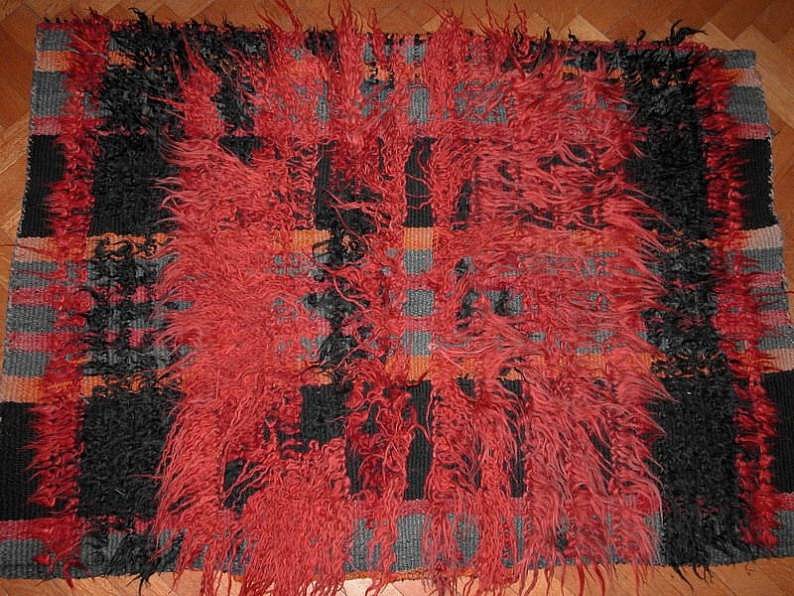



Chile, Mapuche Horse Blanket
The Mapuche Indians of southern Chile were famous for their horseback riding ability. They were the first Americans to learn how to ride horses in the New World. The slit in their tunics opened allowing them to spread their legs over the horse and these were the first true ponchos in the New World. A long pile colorful wool ceremonial horse blanket, which is very rare. A similar one is illustrated in "Colores de America" on the cover.
Media: Textile
Dimensions: Width 34" Height 48"
$6,500
97166
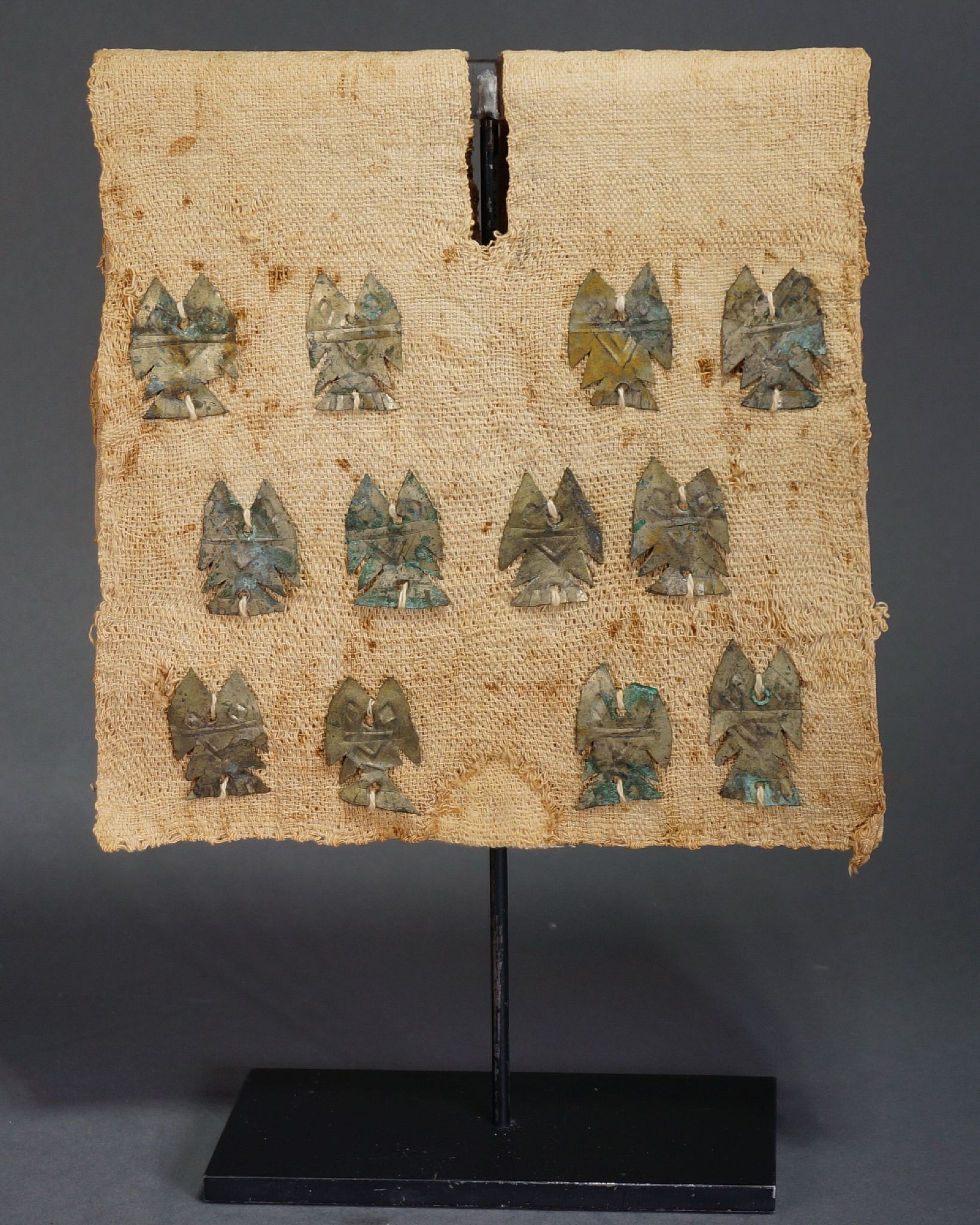


Peru, Miniature Tunic with Fish Appliques
This rare small tunic was made for a child or perhaps a doll. The silver fish are individually crafted - cutout with repousse details. The fish are attached with the original thread, through holes in the fish, and are applied to both the front and back of the tunic. The Metropolitan Museum of Art in New York possesses a similar miniature tunic, pair of shoes, and coca bag, all made in the same style using textiles with square-shaped silver appliques. These items, along with a larger textile, are illustrated in the Textile Museum's publication Costumes and Featherwork of the Lords of Chimor, figs. 148, 167,168.
Media: Textile
Dimensions: Width: 7" x Length: 13 1/2"
$2,500
91201A
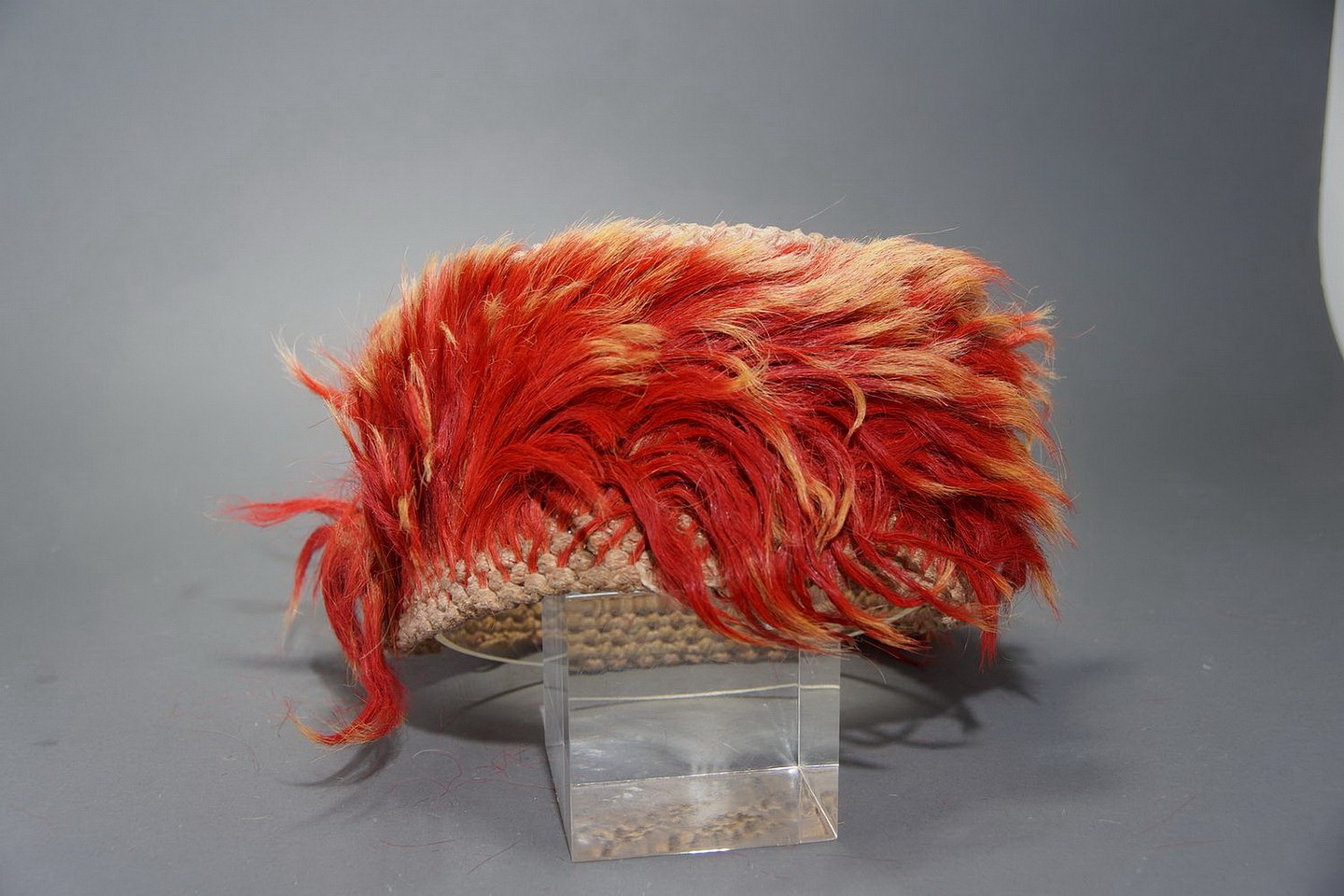




Peru, Nasca Headband with Orange Tie-dye Llama Hair
These unusual headbands are made of a cotton knotted mesh with shanks of llama hair tied into the knots. The inside does not show any of the shanks of hair.
Media: Textile
Dimensions: Diameter 7.5" x Height 4"
Condition: The colors are true without any fade.
Price Upon Request
p1040






Peru, Nasca Slit Tapestry Band with 8 Faces of The Proliferous Being on Red Ground
All eight faces are in the same orientation and alternate between two color arrangements: those with burgundy faces and those with red-orange faces. Each of the faces has a headdress with extensions, a mouth mask with extensions, and fingers holding a horizontal staff. One of the few Nasca tunics which depicts similar face bands and is same width is illustrated in TEIDOS MILENARIOS - ANCIENT PERUVIAN TEXTILES by Jose De Lavalle, page 264-5, ISBN# 9972-717-01-1.
Media: Textile
Dimensions: Lengtht: 45 1/2" x Width 6"
Price Upon Request
M6039
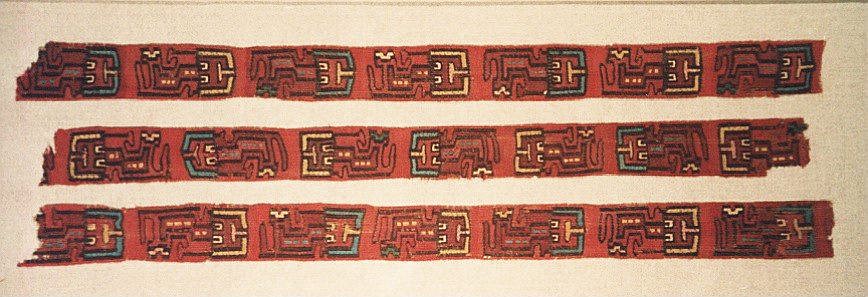


Peru, Nazca Border with 21 Abstract Feline Deities
A Nazca band decorated with seven abstract feline deities alternating in colors blue, yellow and maroon on red ground. The deities face upward, with hind legs and tails outlined in black. When the felines are rotates 90 degrees, they appear to be worms. A similar image is illustrated in Ancient Peruvian Textiles from the Collection of the Textile Museum, plate 17.
Media: Textile
Dimensions: Length: 20" x Width: 7"
$1,800
94178a






Peru, Nazca kilim-style border to tunic with alternating zig zags
The zig-zags on this border are separated by bold triangular fields with ivory, blue and orange on brown ground. This weaving is one of the vertical side borders to the tunic.
Media: Textile
Dimensions: Length 83" x Width 14 1/2"
$11,500
91091
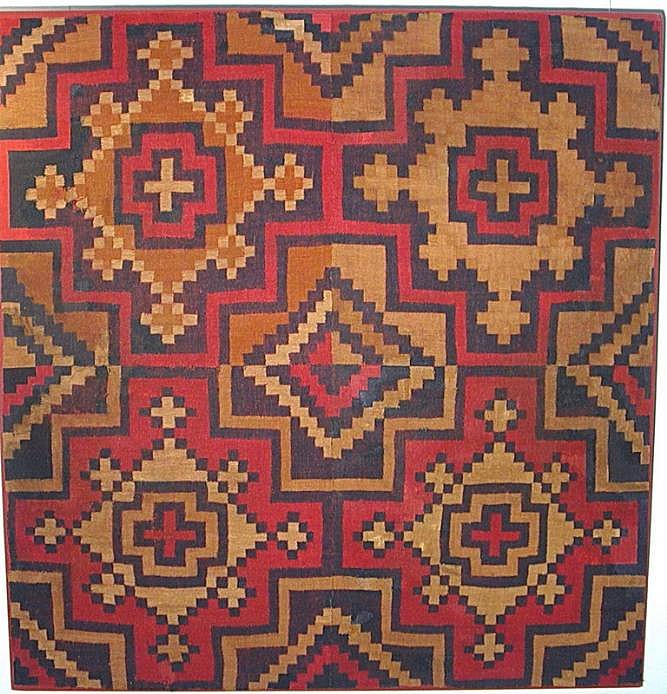
Peru, Nazca Scaffold Weave Panel with five diamonds in red and brown
This is a complete panel woven in scaffold weave with fine yarn, a technique also known as warp-interlock tapestry. Instead of the usual weft construction, the warp is interlocked with another of a different color. Here, the design consists of five diamonds with crosses inside, on alternating colored grounds of gold and red. This panel is illustrated in Mary Schoeser "World Textiles: A Concise History (2003: #62). A very similar example is shown in "Nazca: Arte y Tesoros del Peru (1986: 67).
Media: Textile
Dimensions: Length 42-1/2" x Width 40-1/2"
Price Upon Request
93176
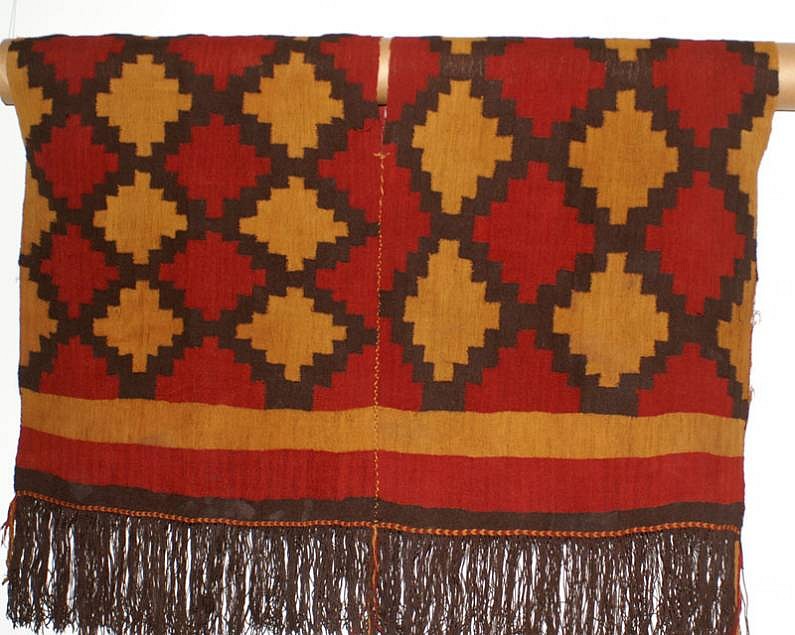
Peru, Nazca Tunic with bold stepped/diamond motif in red, brown and gold.
This scaffold-woven poncho is decorated with a series of complete stepped diamonds alternating in red and gold, outlined in brown. The bottom is bordered by gold, red and brown horizontal bands, with a narrow braid of twisted gold on top of a brown fringe. This tunic was made by two different weavers in the same workshop as seen by the slightly different sizes of diamonds. It's very rare to find a complete tunic intact and unopened.
Media: Textile
Dimensions: Height 34" x Length 42"
$30,000
93076
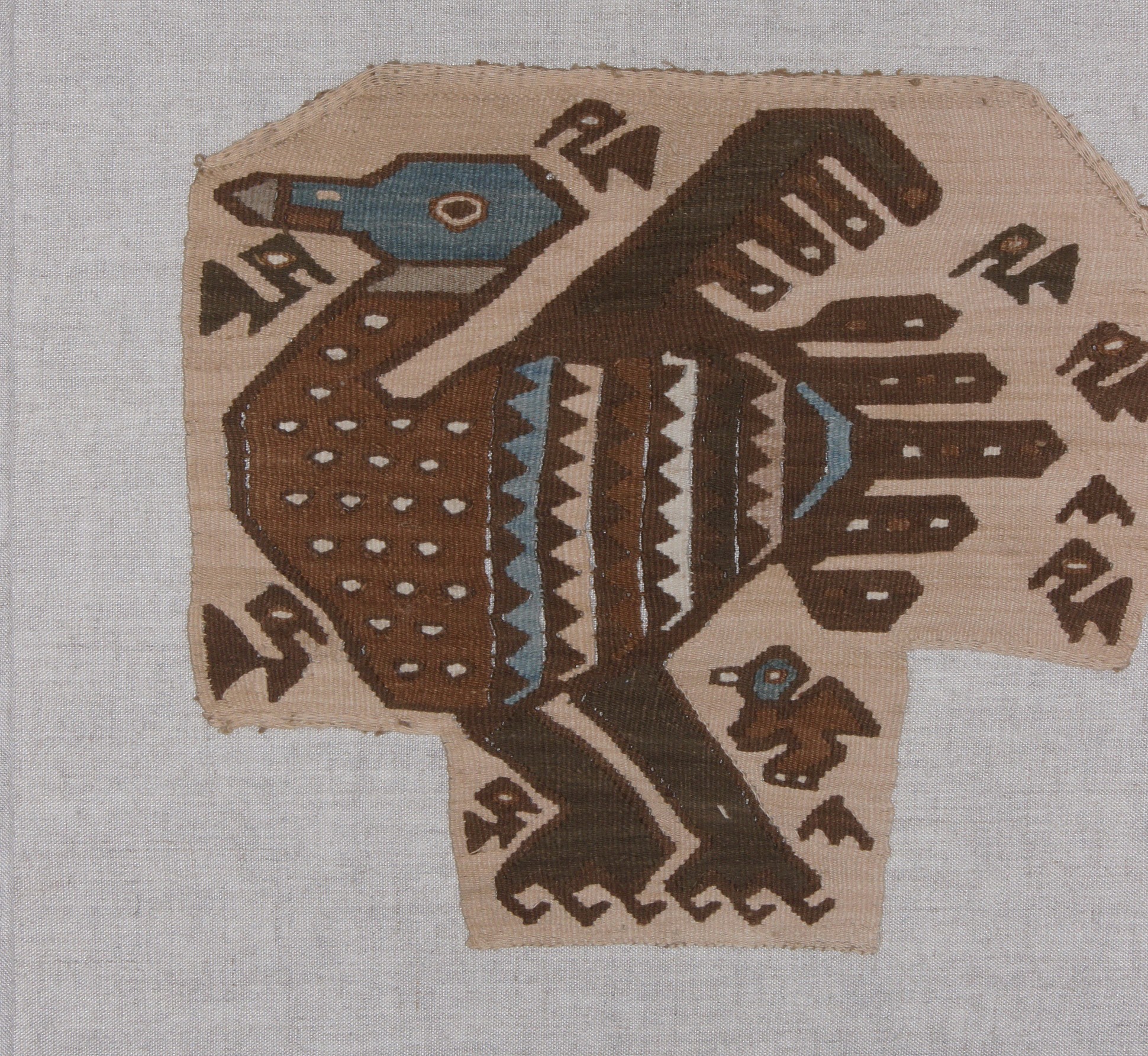
Peru, Pachacamac woven bird
This woven bird is brown, blue and white on a light brown ground, and has a smaller brown bird with a blue head behind it. There are a series of smaller, more stylized birds around the edge of the textile. It was originally woven to be an emblem for tunic and was part of a large cache which was woven for tribute. A similar bird is illustrated in TEXTILE ART OF PERU pg. 276. This is a good example of a woven shaped tapestry as it is not cut.
Media: Textile
Dimensions: Width 17" x Length 20" mounted / length 10 x width 9 in.
$7,500
93127
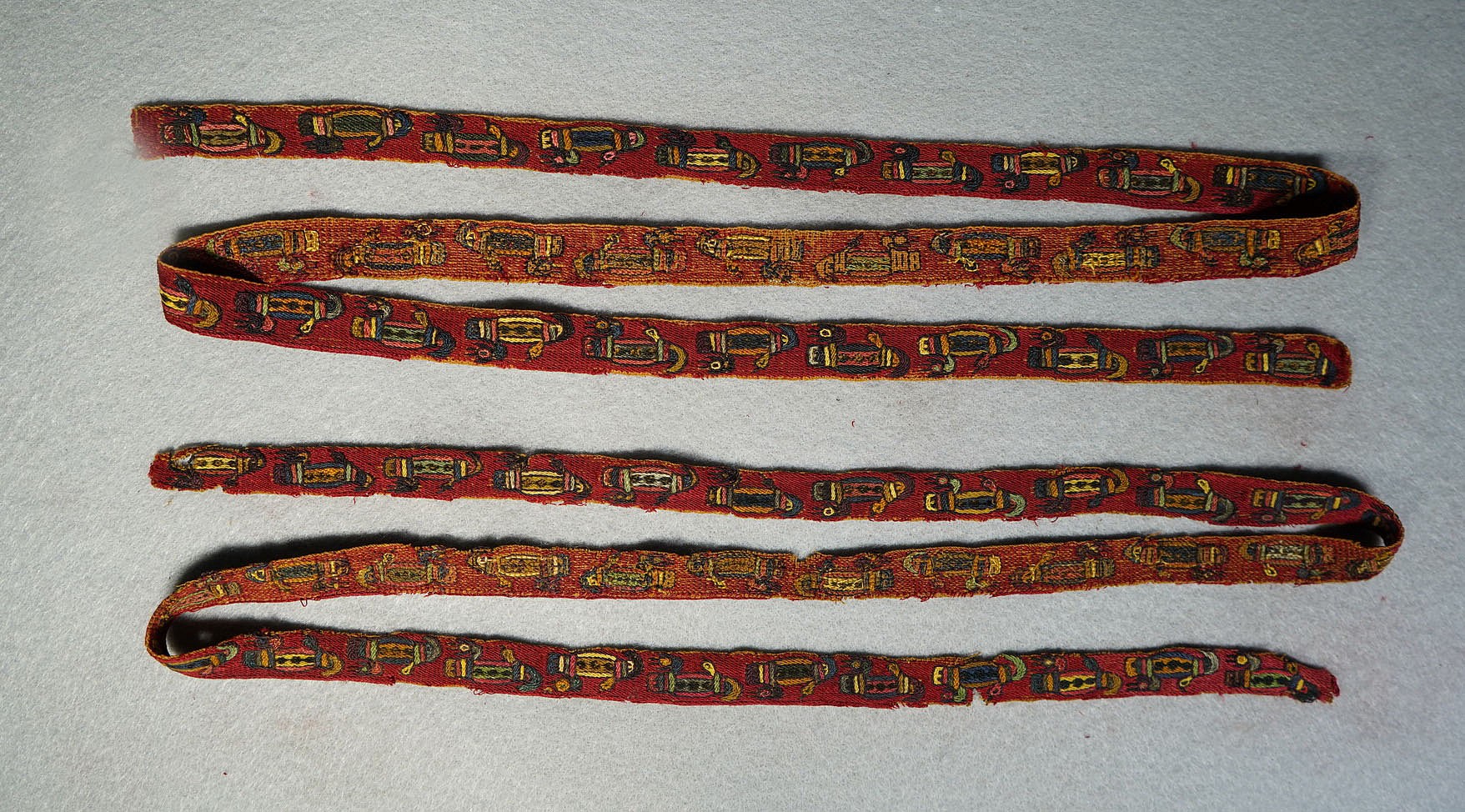




Peru, Pair of Proto Nazca Embroidered Borders with Duck Motif
Weaving technique: embroidery.
These colorful borders to a headpiece were woven with a continuous duck motif in alternating colors on a red ground. When held vertically, the images of ducks appear to be monkeys with faces turned forward, hands held up, and tails curving outward. The weavers used elemental plied wool embroidery, woven with colorful threads through a plain weave of undyed cotton ground fabric. Acquired in 1991 from a California collector prior to the 1980s. Unmounted.
Media: Textile
Dimensions: Lenght: 40" x Width: 12 1/2" each
$2,000
91263
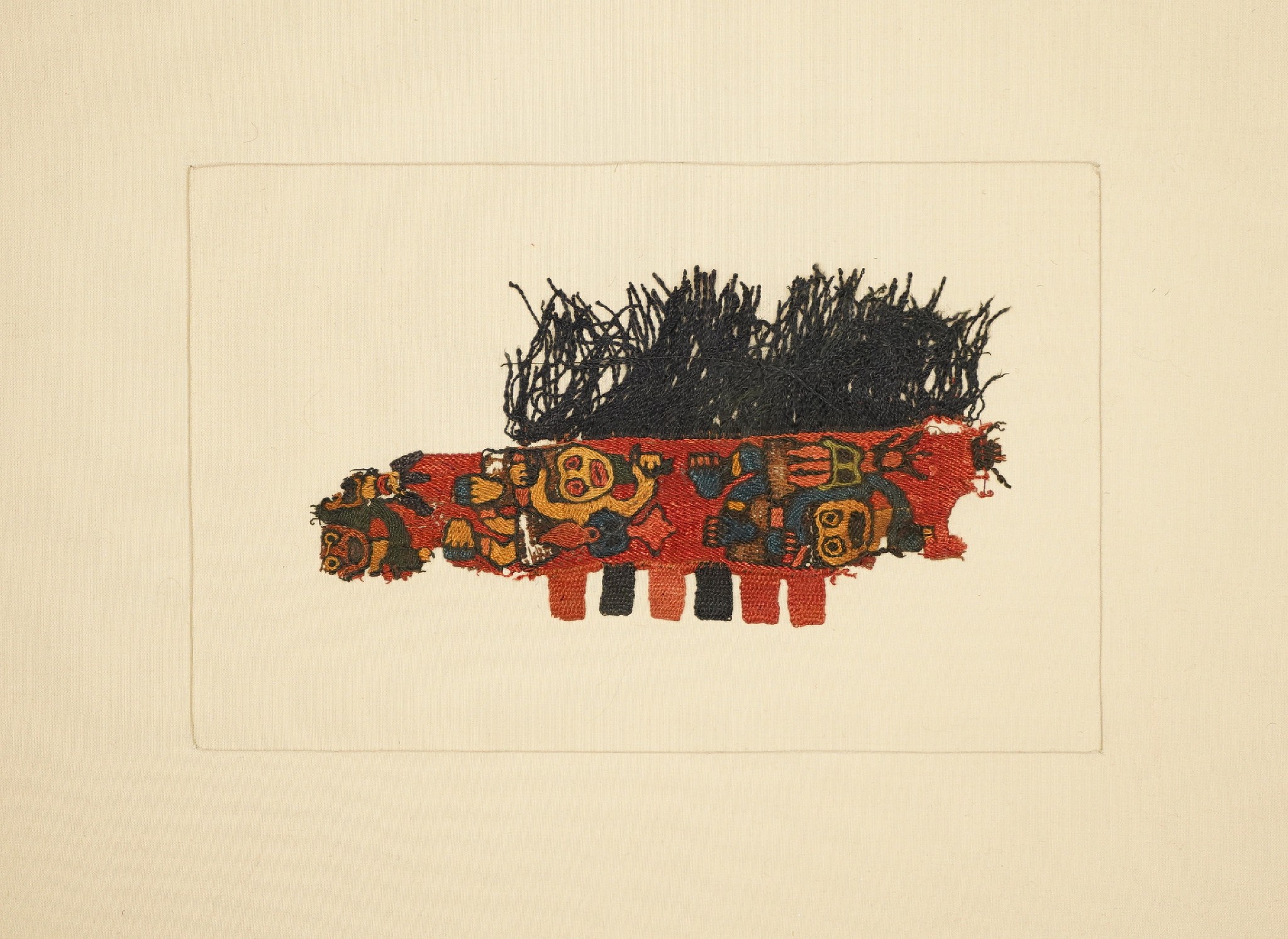


Peru, Paracas Color Block Border Section with Flying Shamans
This Paracas Color Block border section features two flying shamans, both depicted in the same position but reversed (one is upside down) to enhance the perception that they are flying or floating. Each shaman is depicted with a different color palette of bold, contrasting colors including vivid reds, oranges, yellows, and teal, which is characteristic of the Color Block style.Ex. collection Ferdinand Anton, Germany, prior to 1980.
Peru, Paracas, Late Phase, South Coast, c. 200 BC - AD 100
Media: Textile
Dimensions: Border: W. 6 1/4 in. x H. 3 1/4 in. with fringe.
Frame: W. 20 in x H. 16 in.
$600
79143
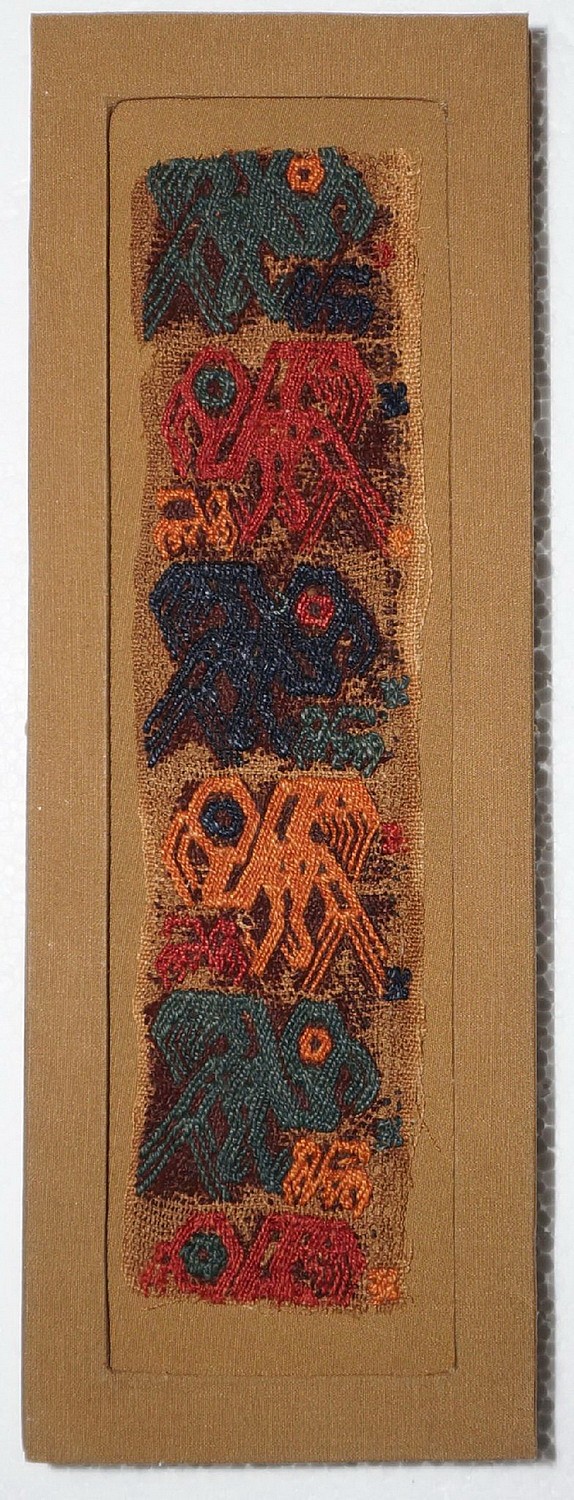





Peru, Paracas Embroidered Section with 5 Condors
This embroidery textile is decorated with five mythical birds of prey in red, green, orange, and dark blue on plain cotton. In front of each large bird is a miniature bird in a contrasting color. This textile is illustrated in ANCIENT PERUVIAN TEXTILES by Ferdinand Anton, 1984, in plate 52. Ferdinand Anton Collection prior to 1980. Excellent color, with slight unraveling at the edges.
Pressure mounted in a Plexiglas frame.
Period: Peru, Paracas, South Coast, c. 500 - 200 BC
Media: Textile
Dimensions: Length:2 1/4" x Height: 7 1/2 "
Price Upon Request
92071
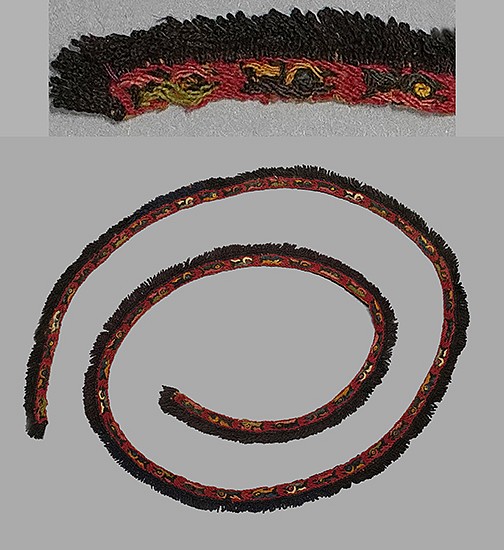



Peru, Paracas Miniature Embroidered Fringe with 59 Killer Whales
Weaving technique: embroidery with looped fringe.
This small-scale fringe was a border to a miniature garment. The whales repeat in alternating colors in sets of sections of seven whales. There is a solid dark blue-black outer fringe in excellent condition, which is finished at both ends. Traditionally, young children in the Andes do this type of embroidery, as they are the only ones who can work with such small detail. Acquired in 1998 from a California collector prior to the 1980s. Both ends are finished to make a complete fringe. Unmounted.
Media: Textile
Dimensions: Length: 35” x Width: 3/16”
$1,900
T-19



Peru, Paracas Miniature Knitted Fringe or Neck Opening with Double-Headed Worms
Eleven finely knitted colorful segments depicting double-headed worms with curled tails in alternating colors. Below each worm is a small tab with an even smaller creature nested within. Acquired from the estate of Anton Roeckl in Germany prior to 1970.
Media: Textile
Dimensions: Length: 6 3/4 inches
$2,800
96165






Peru, Paracas Necropolis Embroidered Corner Border with Eight Large Feline Figures and 100 Secondary Figures
This symbolically rich Linear style Paracas mantle border features a group of magnificent animal deities, ranging from ferocious to benevolent. The eight main deities are feline Oculate Beings with exaggerated eyes, alternating in orientation, each with a tongue terminating in a serpent's head. Oculate Beings in Andean art often resemble the Pampas cat, Leopardus pajeros - a distinctive species of wild cat with unusually large eyes found along the Pacific coast of South America. Inside each of the Oculate Beings' torso is a double-headed condor, and a variety of small, colorful, attendant felines are embroidered around the perimeter of the design.
The Oculate Being with a smaller animal nested inside of it is a classic Andean shamanic trope that signifies death, rebirth, and transformation. Rather than representing the literal birth of an individual animal, these chimeric creatures, skeletal in form, nested inside the abdomens of the larger Oculate Beings represent a mythical cosmology of reverence rebirth and transformation.
The Paracas cosmology is also present in the abstract structure of the composition, which suggests the ambiguous boundaries between the earthly realm and the spiritual world. South American shamans are known to fast and chant in preparation for a voyage into the spiritual world. The lack of perspective and the absence of recognizable landscape features in the design of this textile signifies an intermediary zone outside the normal bounds of space and time, accessible only to shamans and spirit animals who can traverse the boundaries between worlds.
Red and pink threads of extremely similar hue were intentionally selected by the Paracas artisans to create an optical illusion that causes the smaller figures to appear to be emerging from the composition over time. This type of optical illusion using color only to create the sensation of forms emerging over time was also used in the abstract paintings of Modernist Ad Reinhardt.
Expert knowledge of color theory was used to select perfectly contrasting colors, creating an optical illusion in which some of the deities appear to vibrate, while others appear to merge into a unifying field of color. With prolonged observation, the scene in the textile appears to oscillate, and the deities appear to be moving. The changing imagery and perceptual illusion of motion created through use of compositional elements alone shares qualities with paintings of some of the greatest early 20th Century Modernists, including painter Wassily Kandinsky.
Kandinsky believed that each color had a spiritual vibrational property aside from its’ electromagnetic wavelength, and that colors could profoundly affect the human spirit. Kandinsky wrote about these concepts in his 1911 treatise, Concerning the Spiritual in Art. Also see Anne Paul's PARACAS RITUAL ATTIRE: Symbols of Authority in Ancient Peru, University of Oklahoma Press, 1990. p. 170. Professionally conserved and pressure mounted in a Plexiglas frame. Acquired by David Bernstein in 2003.
Period: Peru, Paracas, Ocucaje-South Coast , 300 - 200 BC
Media: Textile
Dimensions: Length 45" x Width 9 3/4"
Price Upon Request
M4003
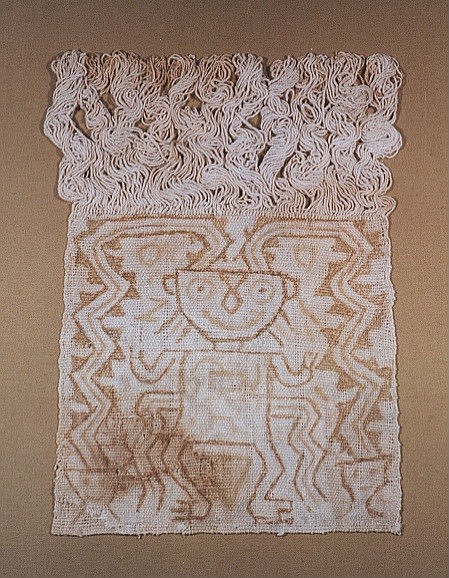
Peru, Paracas Painted Mummy Mask Textile with Figure and Serpents
The Paracas culture is known for its elaborate and whimsical painted textiles as well as its mummy masks, which were placed over the faces of the deceased. This cotton textile is woven in white thread and painted with varying shades of tan and brown pigment. The mysterious central deity is depicted standing with his arms and legs turned outward. Serpentine creatures emanate from either side of his head, their miniature faces resting at the ground near his feet. The cotton warps form a fringe along the top border. Ex. collection Pablo Soldi-Lou Slavitz in the US prior to 1960's.
Media: Textile
Dimensions: Height: 16" x Width: 8"
$3,400
92005
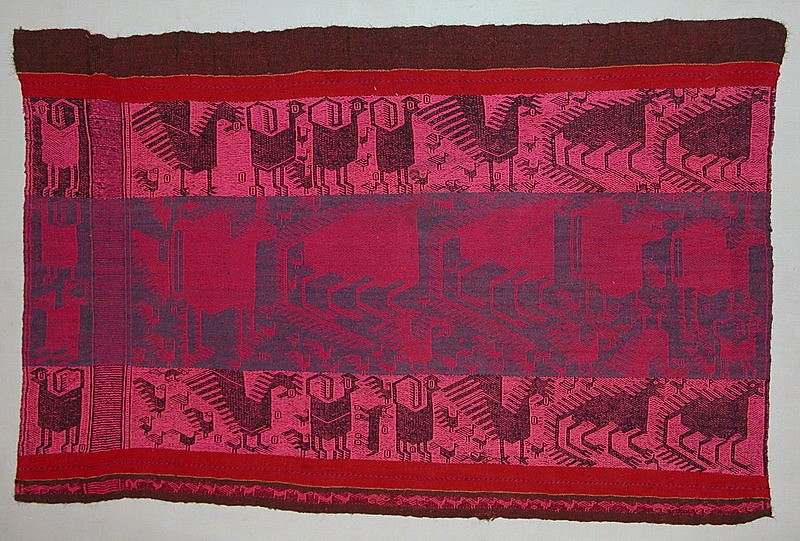
Bolivia, Potolo Llacota Mantle with Mythical Animals in Pink and Blue on Maroon Ground
These fantastic animals, demons and monsters are unique to Potolo. These creatures and are said to be envisioned by young women who participate in a ritual that involves spending the night in a cave, likely while using entheogens. This coming-of-age ritual and the visions of demons and strange animals are considered a part of the young Potolan woman’s passage from childhood into adulthood. Potolan weavings, and the animals they portray are associated with sexuality and fertility. Mounted on a stretcher.
Media: Textile
Dimensions: Width 39" x Hieght 29"
$2,900
89256
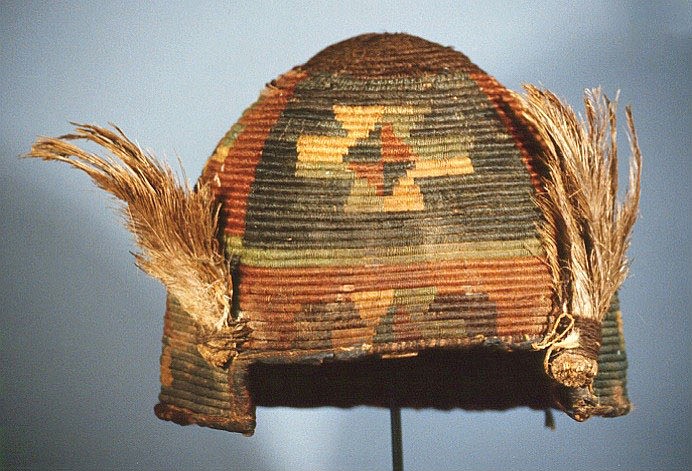




Chile, Pre-Inca helmet from Chile with Extended Cross Design
A coiled and reed cone shaped helmet and decorated with crosses within squares in alternating colors of blue and salmon with a blue lower border. A similar helmet is illustrated in IDENTITY AND PRESTIGE IN THE ANDES pg.44. The Andean civilizations never developed a piercing technology but utilized a clobbering warfare and needed insulated
Media: Textile
Dimensions: Height 11" Diam 9"
Price Upon Request
91131
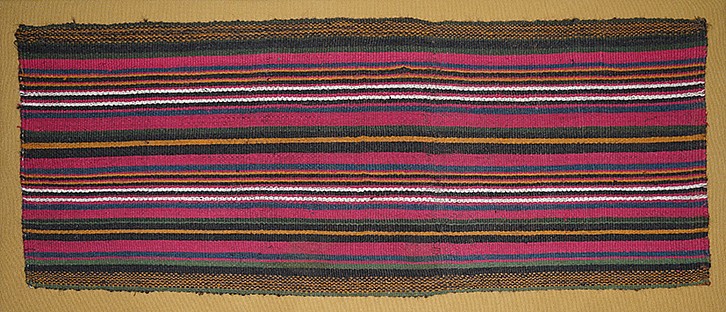



Chile, Pre-Inca Storage Bag from Arica, Chile
This large striped bag is decorated with a series of thin and broad vertical stripes in brilliant hues of red, green, tan, brown and white. The weaving was opened along the vertical sewn sides and is in excellent condition indicating that it was woven for ritual tribute rather than used in everyday life. These long, narrow bags are referred to as talegas. A group of talegas is catalogued in ARICA: 10,000 YEARS, ref # 195-199. Acquired in 1995 from Eduardo Aldunate, Santiago, Chile prior to the 1980s. Weaving Technique: plain weave. Professionally mounted on a stretcher.
Media: Textile
Dimensions: Length 29" x Width 13"
$5,800
95107
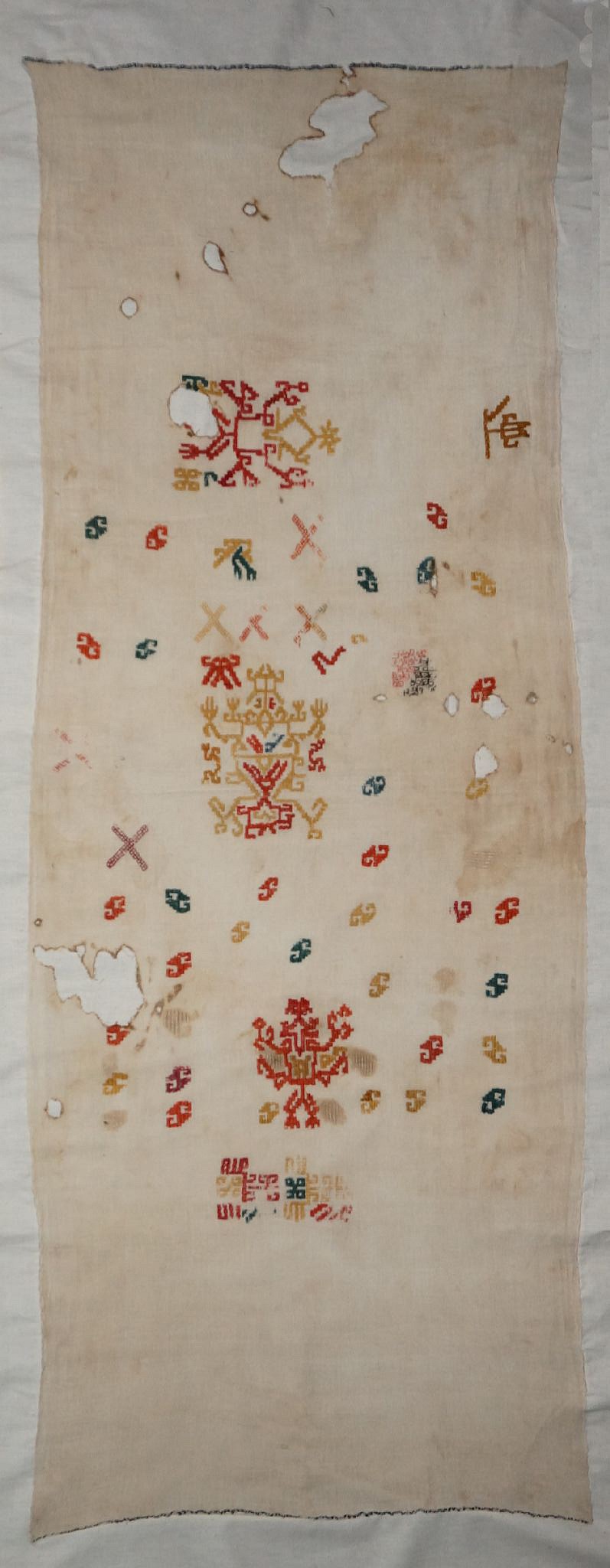



Peru, Proto-Nazca "Cabildo" Sampler with Three Figures in Gold and Red
This sampler is embroidered with abstract creatures with their hands held upwards. The sampler is embroidered with camelid dyed fiber in red, green and gold on a fine woven white cotton ground. The two figures at opposite ends have arms and legs with fancy appendages at the waist and an abstract face on top of each head. Samplers were used by the Paracas and Early Nasca to plan out designs for large textiles. The central figure appeas to be a shaman with a large head wearing a crown with three appendages on each side embroidered in gold. Nested inside the central figure is secondary figure embroidered in red, depicted upside down as if it is falling. The sampler is embellished with 42 individual connected step-volute patterns in red, green, gold and brown. In addition, there are five X's interspersed in the design. The panel is complete, in good condition, with all sides selvaged, and professionally lined. There are 3 small holes and 7 very small holes. Similar samplers are discussed and illustrated in "Early Nazca Needlework" by Alan Sawyer.
Period: Peru, Paracas, Ocucaje-South Coast , 300 - 200 BC
Media: Textile
Dimensions: Length: 63" x Width: 22"
$6,500
93129
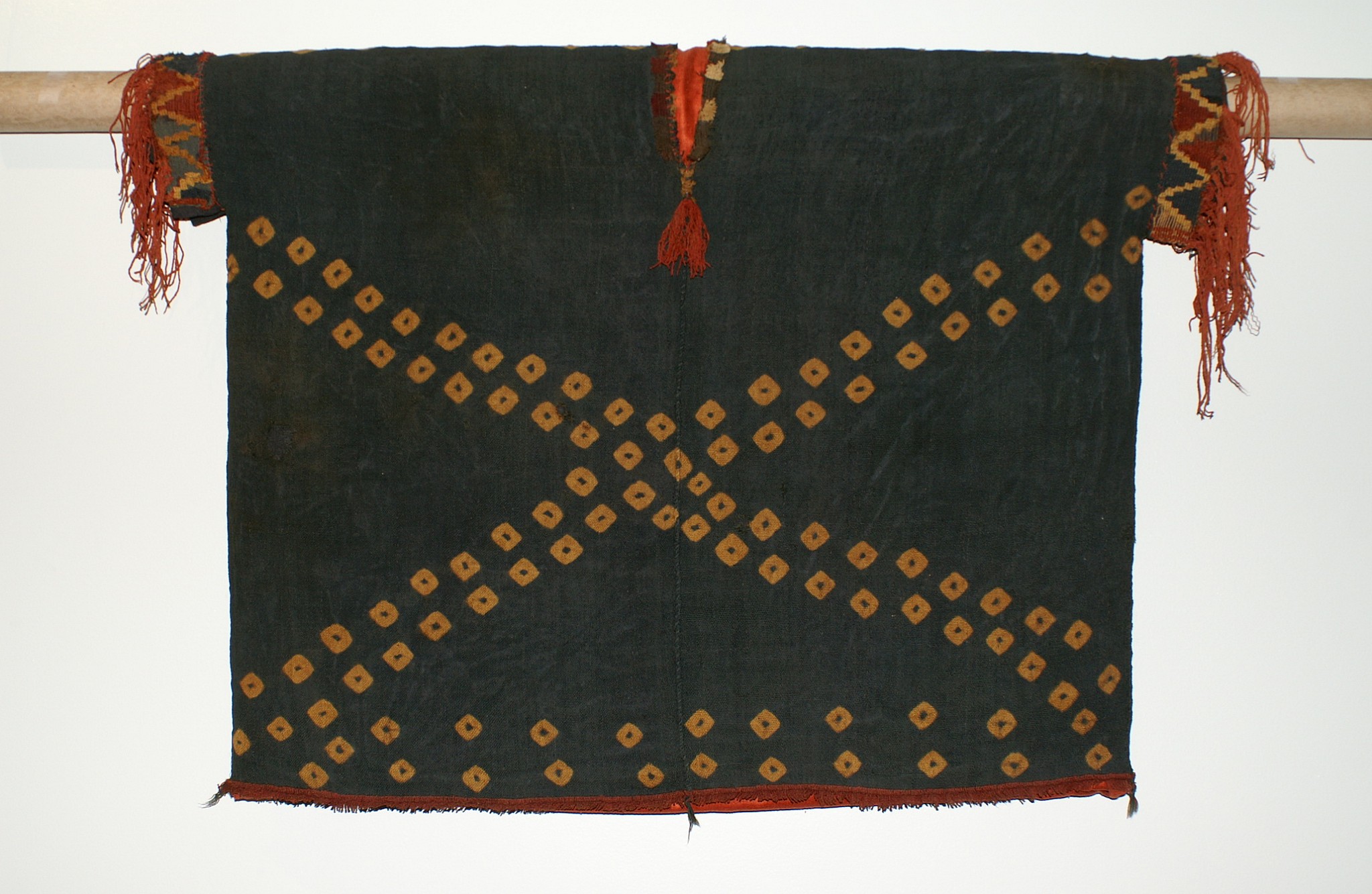



Peru, Sihuas Green Sleeved Poncho with tie-dye pattern
This is a nice poncho with diagonal yellow motifs against a green ground and red borders.
Media: Textile
Dimensions: Height: 27" x Width: 32"
Price Upon Request
M7159
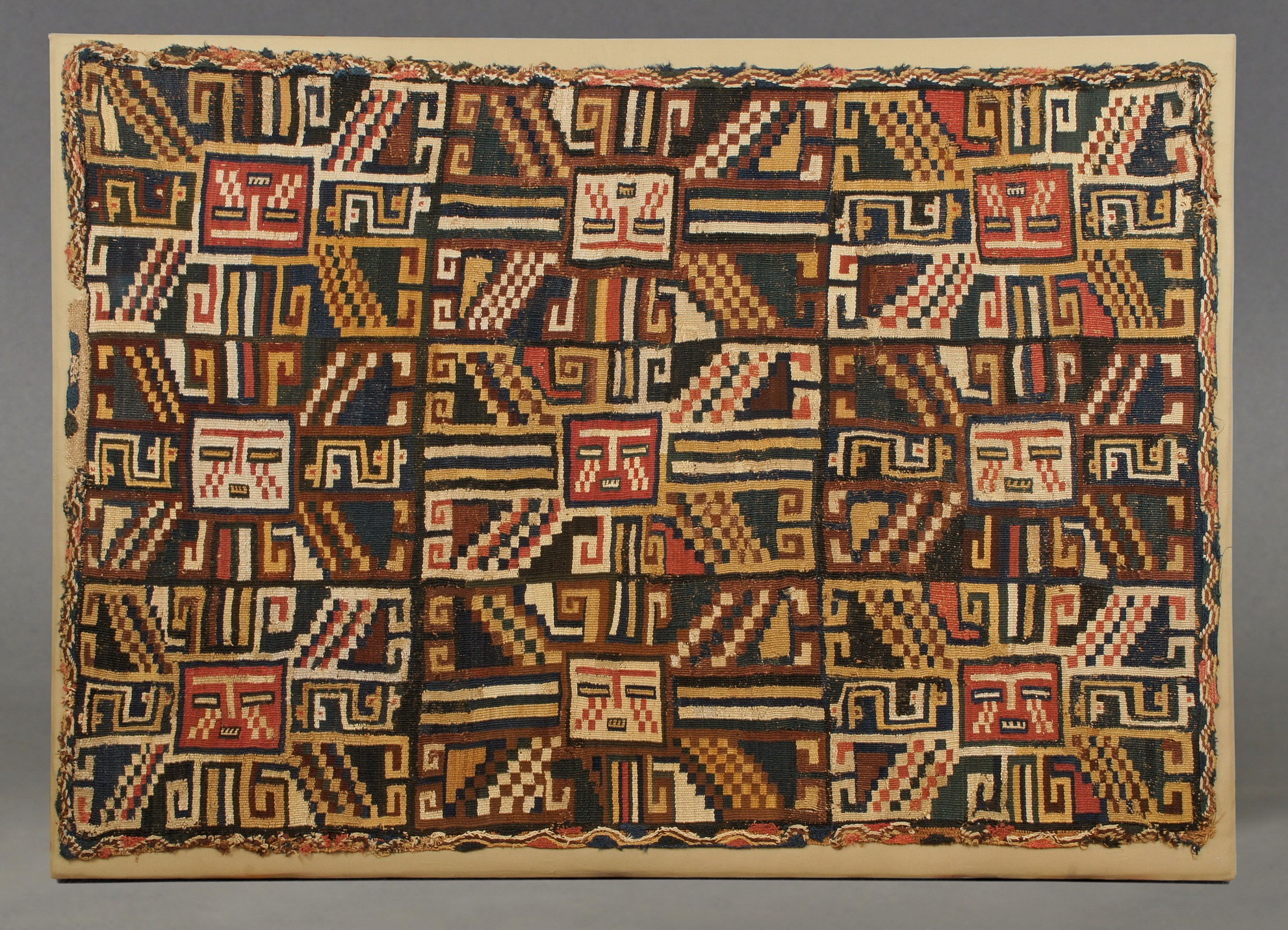



Peru, Sihuas Mantle with nine sun faces
The Sihuas sun face image was derived from the Tiwanaku Moon god. On this textile, the images are arranged 3 x 3 alternating in red and white sun faces. Rare double interlocking warp and weft with edges finished in the original pattern of a complicated oblique weave. According to Jorge Haeberle who has studied Sihuas textiles, this is one of only three known garments of this type. He thinks it was a head cloth with the opposing row of faces folded over from front to back showing the sun faces right side up on the front of the forehead. This weaving is very complicated and from the earliest Sihuas phase around 300 - 100 BC. There have been several larger Sijuas textiles with just a single sun face, while this one with the rows of faces compares to or perhaps influenced early known Tiwanaku and Pucuara weavings. The Sihuas complex of weaving began about 500 BC and was contemporany with Paracas embroideries. The Sihuas culture was eventually absorbed by the Nazca in the seventh century.
Media: Textile
Dimensions: 37 1/2" x 46"
Price Upon Request
MM801
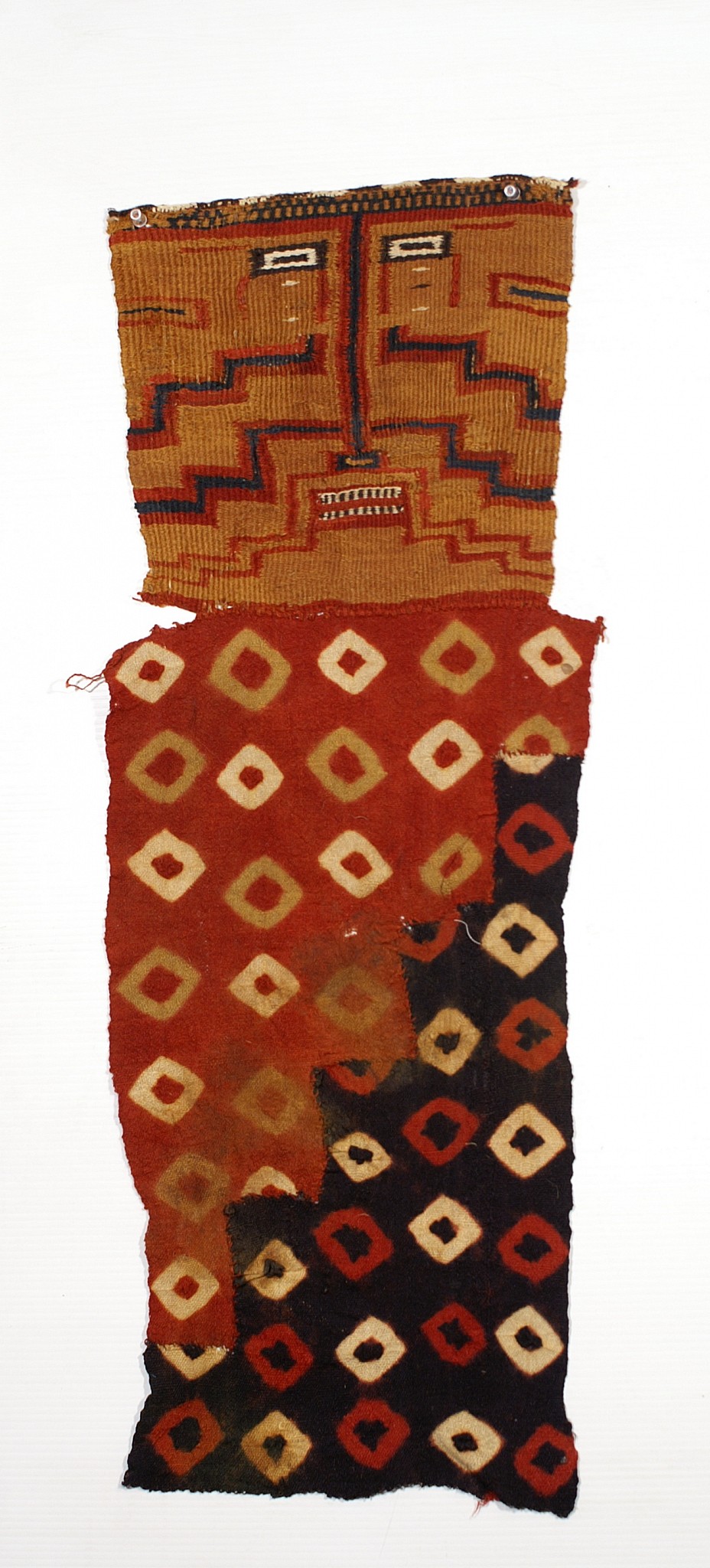
Peru, Sihuas Mummy Mask with tie-dye panel (twin blue)
This group of four panels represent a very rare type of textile in which the woven cloth was attached to a tie-dyed skirts. It seems that all four had ties at the top of the head. These textile figure cloths were probably placed over the deaceased in tombs. They date to the Sihuas III Phase.
Media: Textile
Dimensions: Height 46"x Width 24"
$25,000
M8050
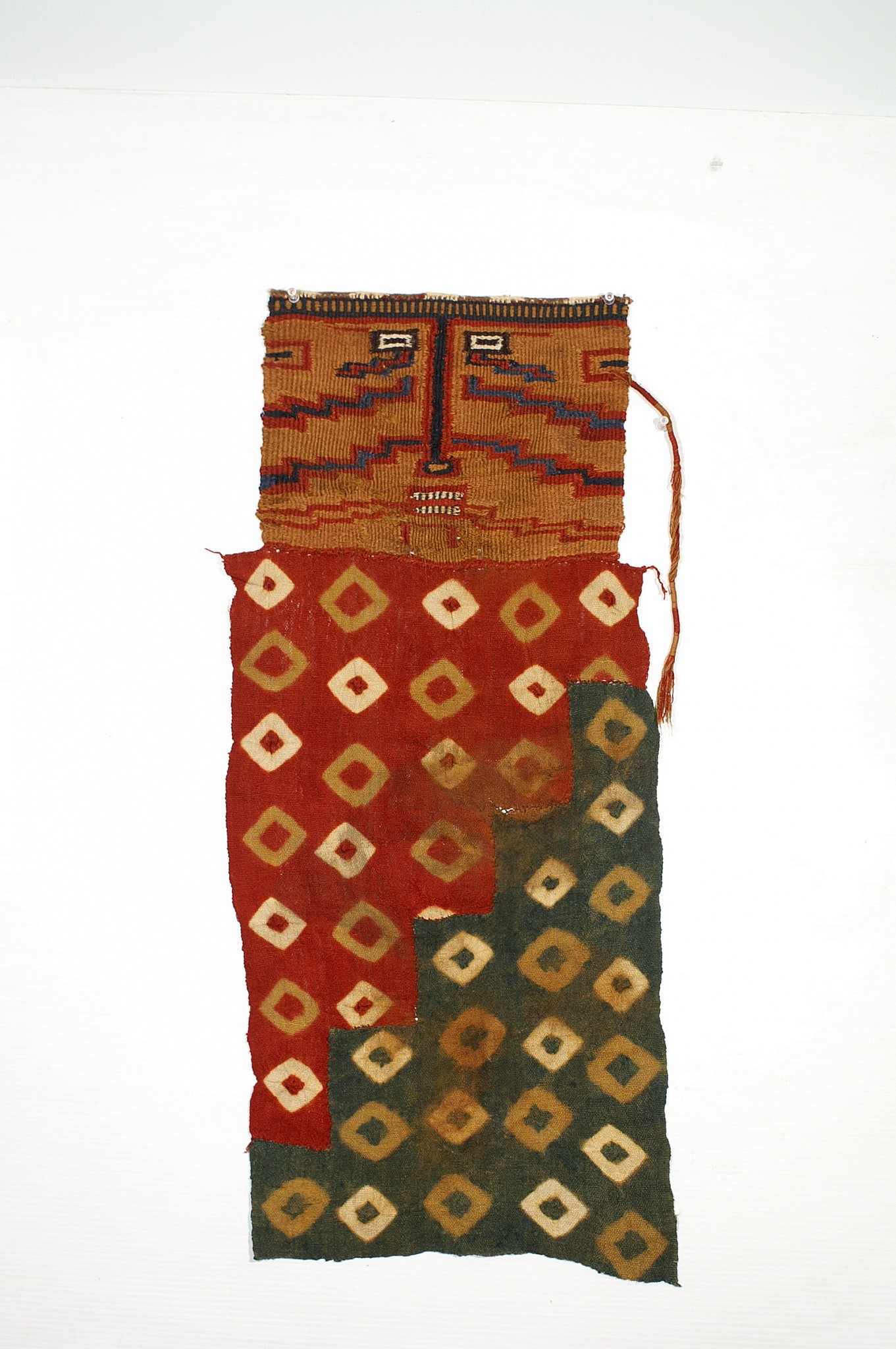
Peru, Sihuas Mummy Mask with tie-dye panel (twin green)
This group of four panels represent a very rare type of textile in which the woven cloth was attached to a tie-dyed skirts. It seems that all four had ties at the top of the head. These textile figure cloths were probably placed over the deaceased in tombs. They date to the Sihuas III Phase.
Media: Textile
Dimensions: Height 46" Width 27"
$25,000
M8053
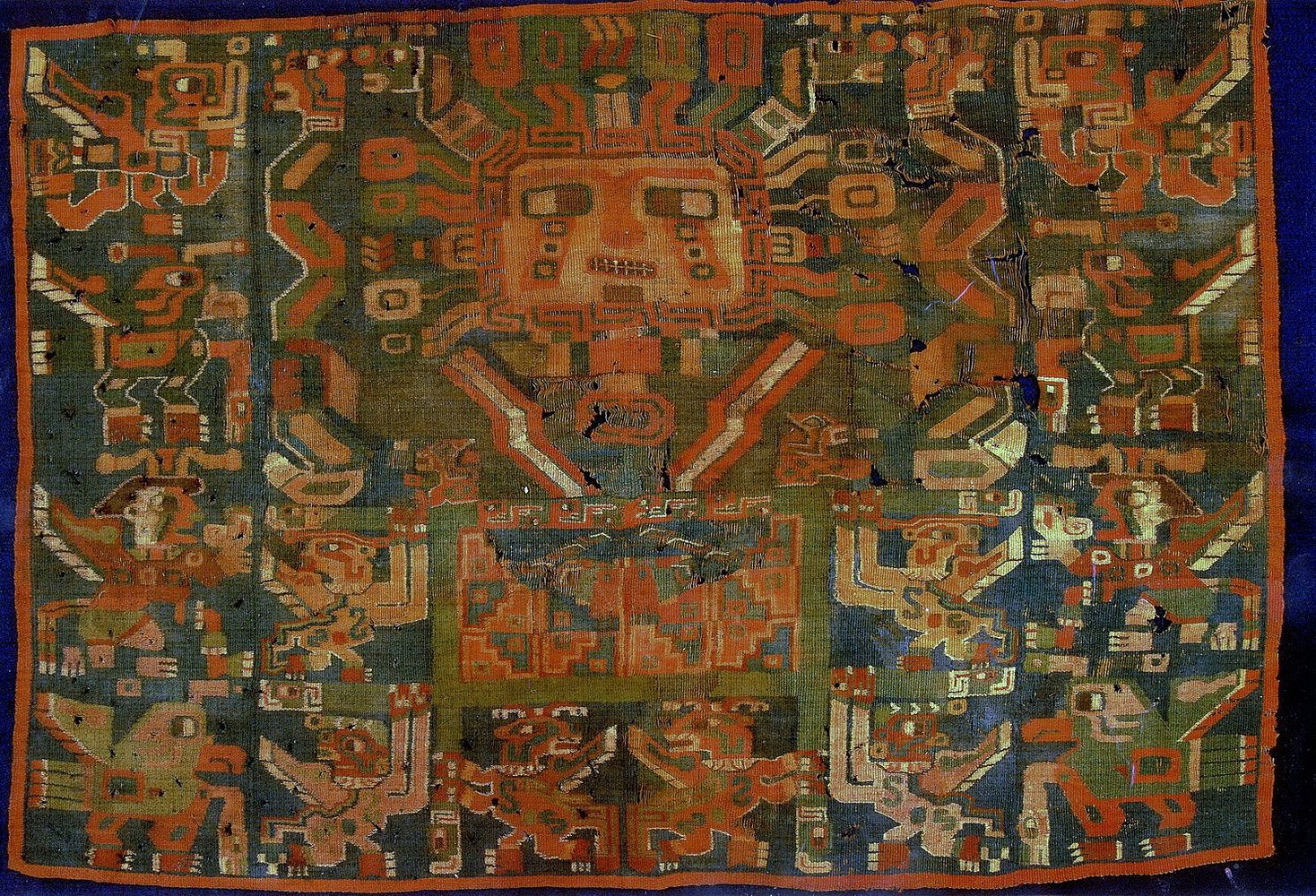





Peru, Sihuas Tapestry Panel Depicting a Sun Face Deity Holding a Staff in Each Hand
The panel depicts an elaborate Sun Face Deity holding fancy staffs with Puma heads in profile. The Deity wears a colorful headdress and an unusual chest decoration. Beneath the deity is a litter held by four attendants. In the center of the litter is a self-referential depiction of a tunic. Underneath the litter are two staff bearers that appear in front of the litter. On each side is a column of four unique kneeling anthropomorphized attendants with bird-like characteristics. Among the attendants are two figures with human faces who are blowing conch trumpets. A similar, less complicated example is illustrated in TIWANAKU: ANCESTORS OF THE INKA by Maragaret Young-Sanchez, fig. 1.9. Condition: There are losses and repairs throughout.
Media: Textile
Dimensions: Height: 20" x Width: 29"
Price Upon Request
N6012
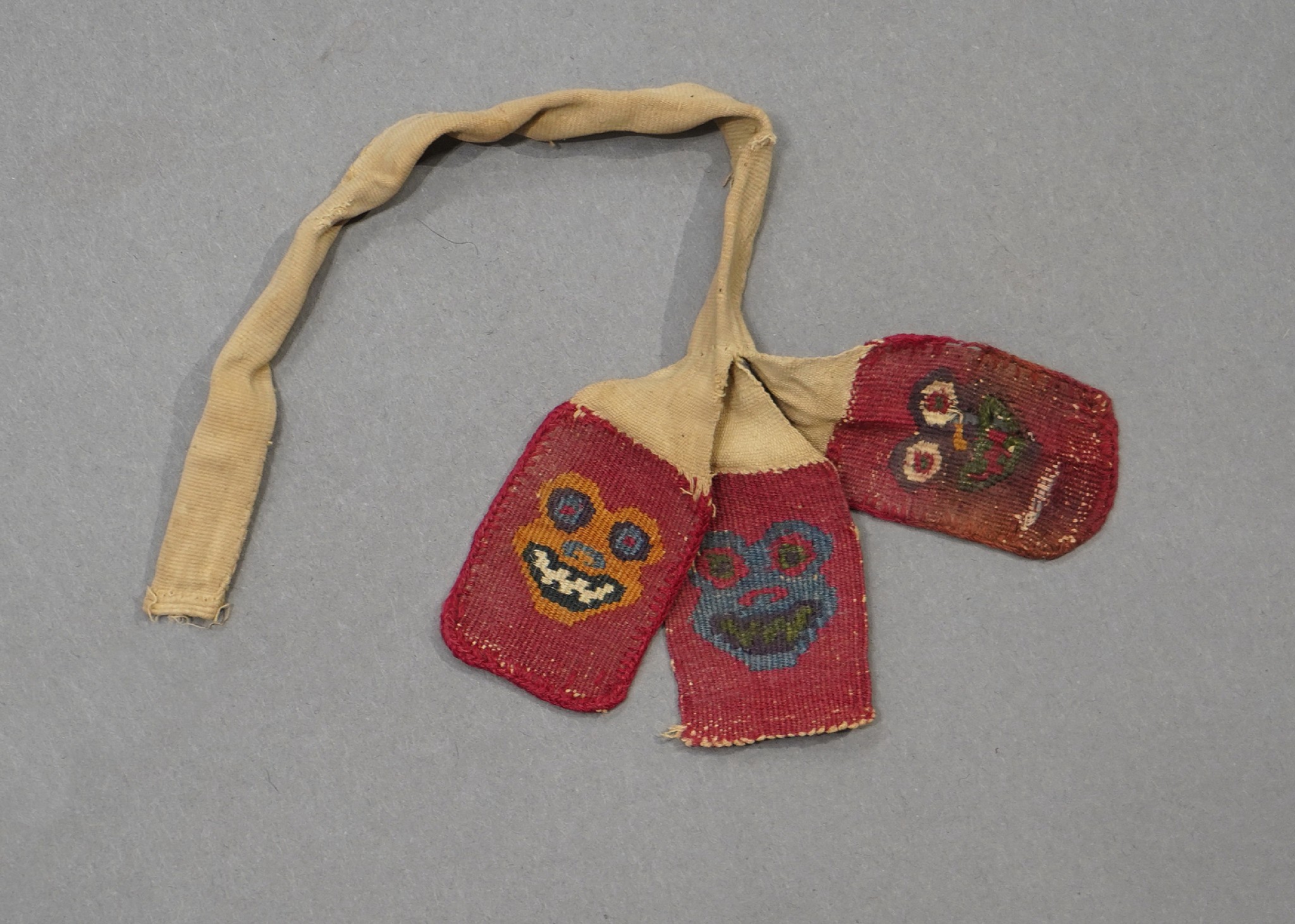
Peru, Three Wari Woven Tabs with Animal Heads
These woven tabs with stylized grinning toad faces were once part of a sash. The tabs are woven in orange, green, blue, white and black on a red ground. A similar set of tabs is illustrated in Animal Myth and Magic,by Vanessa Moraga, p. 110.
Media: Textile
Price Upon Request
91095a
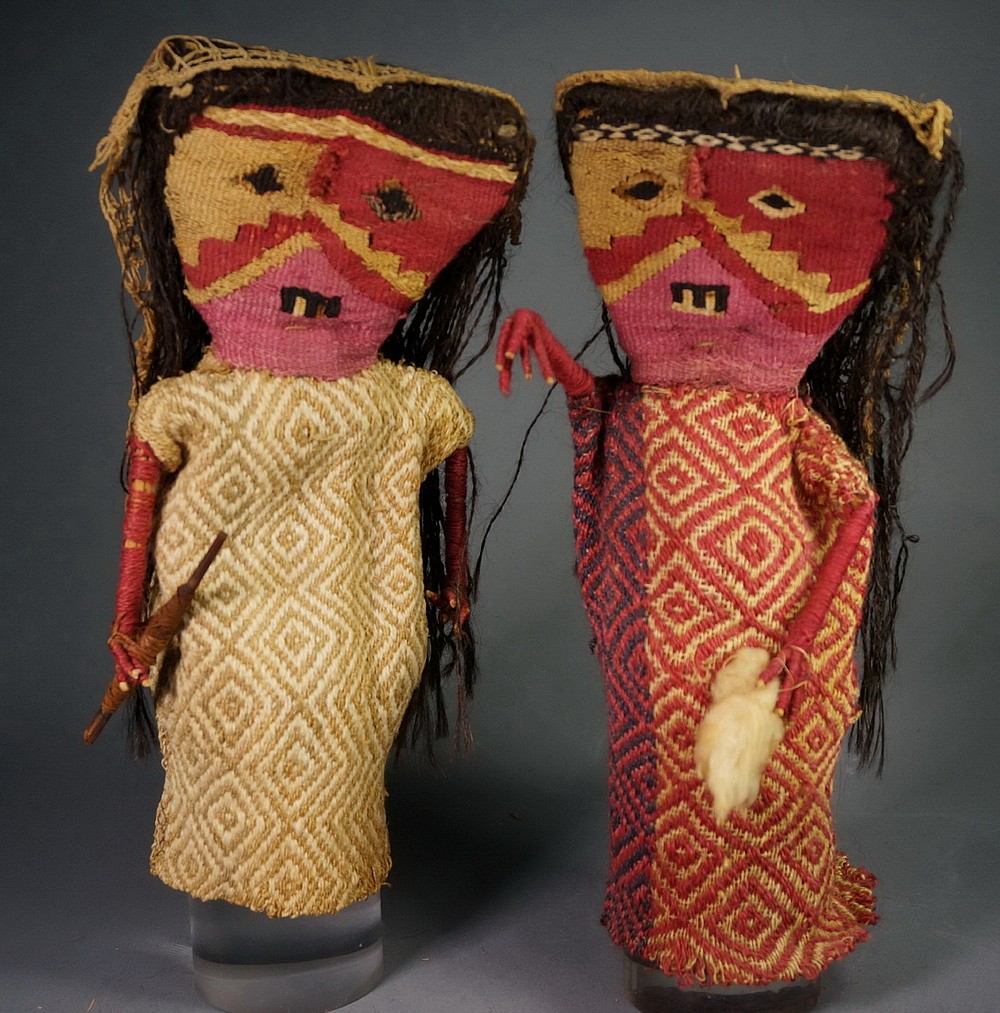





Peru, Two Female Chancay Dolls
The female tapestry faces are divided into three sections while those of the males are woven in two sections. One holds a wad of unspun cotton while the other holds a spindle with brown cotton strapped around it. Each has a witch’s veil covering the back of the head. Ex collection Justin and Barbara Kerr, prior to 1970.
Media: Textile
Dimensions: Height: 10 1/4" x Width of Face: 4 1/4"
$8,500
n7013
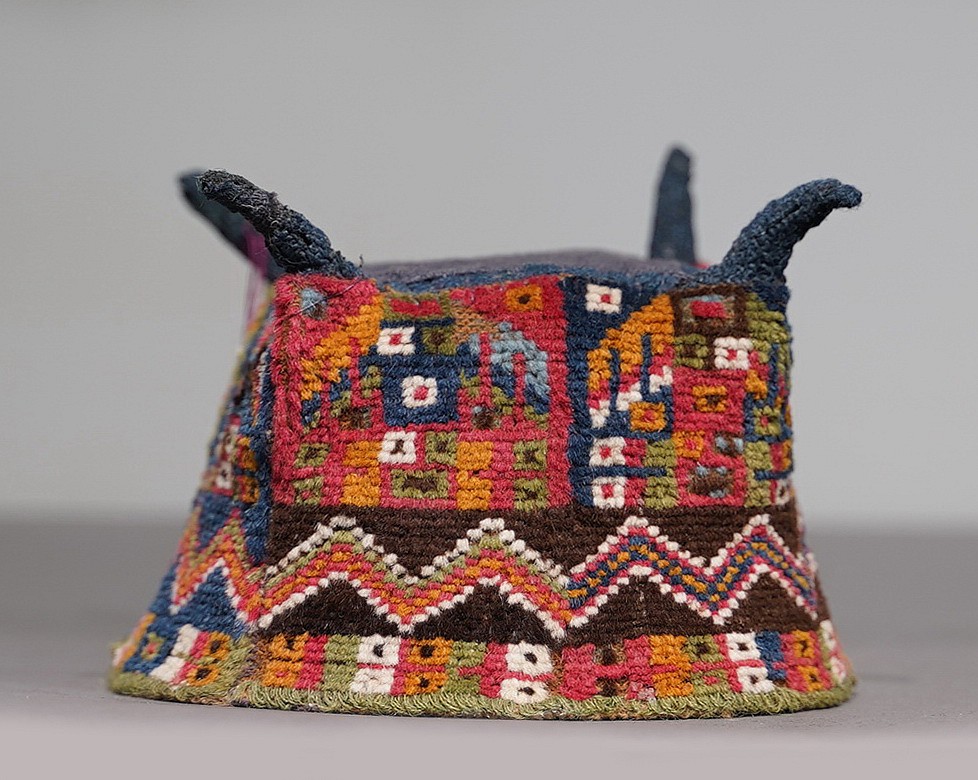





Peru, Wari Four-Corner Pile Hat Decorated in 3 Registers
The top register of this hat features 7 repeating panels in alternating colors, with background colors in red, green, and blue. The figure depicted in each panel is a totemic column consisting of (1) an abstract Rayed Deity’s face at bottom (2) a second deity face (in the middle) and (3) an elaborate headdress representing a bird with outstretched wings at the top. The faces and feather motif may derive from the Frontal Staff Deity, a major figure in Highland iconogpahy. The second register features an undulating band of white, red, blue, tan, and gold, on a dark brown ground. The lower register features a beautiful repeating band of geometric designs on a green ground, representing 8 repeating Reyed Deity faces. A four-cornered pile hat with similar elements is in the Metropolitan Museum of Art’s permanent collection. From the estate of Leslie Orgal, PhD - La Jolla, CA. prior to the 1980s.
Media: Textile
Dimensions: Height:. 4 1/2". x Length: 4" x Width:. 4"
$6,500
p4125
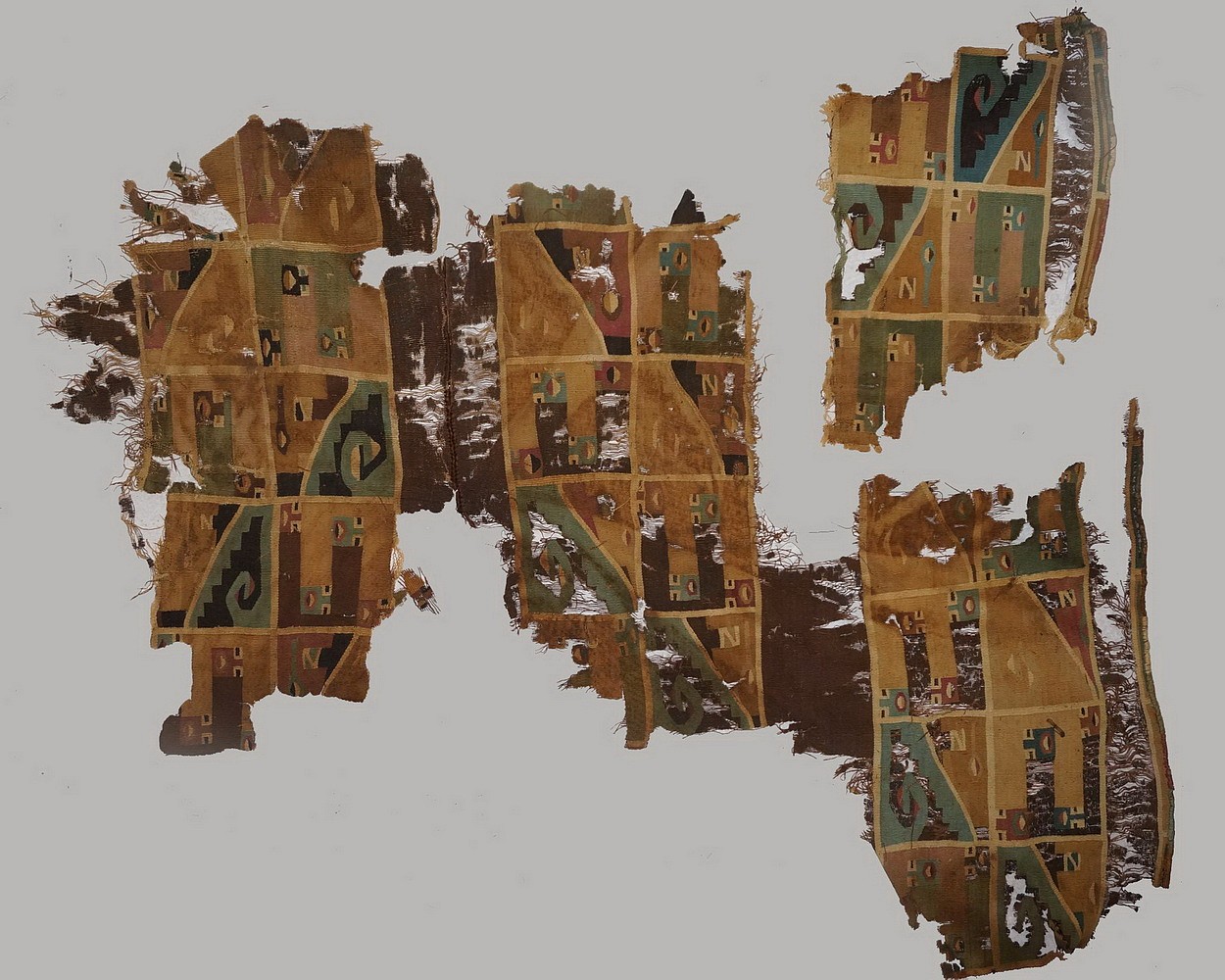



Peru, Wari Tapestry Sections to a Tunic from the Highlands
The tunic is a very finely woven section which depicts the classic step fret and puma motif. One large section includes the central seam with compressed design. Originally the tunic was woven with four bands of design separated by solid brown bands and the side seams had a compressed design. The warps are twisted with brown alpaca and white cotton indicating that the tunic was woven in the highlands. Included with the two main sections there are four additional sections that are incomplete.
Media: Textile
Dimensions: Width: 30" X Height: 30"
Section: Width: 8" X Height 10"
4 extra sections measure from widths 5 1/2" to 8" and height from 5 1/2" to 12"
Price Upon Request
n7062
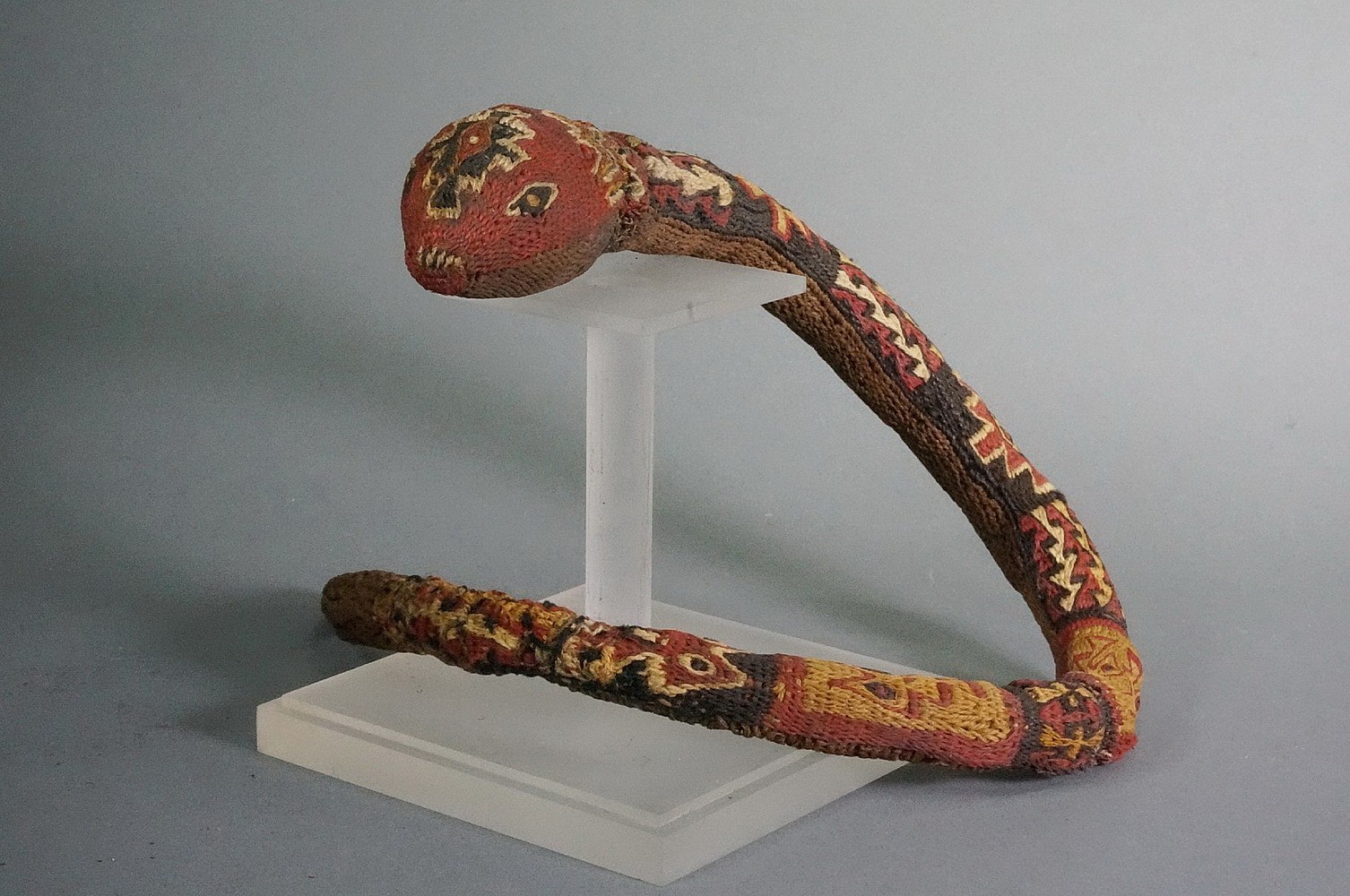




Peru, Wari three dimensional coil woven snake dance wand
Shamans use dance wands hypnotize their attendants. This wand has 6 different patterns on its back and a solid brown underside. The tip has a 3" section of woven hemp which appears to be poisonous. There are many poisonous snakes in Peru including the dangerous Bushmaster. Formerly in the collection of Justin and Barbara Kerr, acquired from Alan Lapiner in 1967.
Media: Textile
Dimensions: Length: 19 1/2" x Diameter: 1 1/2" tapering to 3/8"
Price Upon Request
n7016








Peru, Wari Tie-Dye Panel in Longstrip with Diamond Resist Motif
This panel highlights the complex dye techniques which used in ancient Peru. There are two shades of red, the darker shade has been overdyed. The first time the panel was dipped into the dye bath, several circles were tied off and the entire panel was dyed red. The tied circles remained white and more circles were tied into the fabric. The panel was then dipped into a second bath of a darker red dye. This created the light red circles and the white circles on a dark red background. The ends are finished with a knit trim, dyed green, yellow, and red.
Media: Textile
Dimensions: Length: 83" X Width: 4 3/4"-5"
Price Upon Request
96121



